Motorola Mobility T56AS1 Portable Cellular Transceiver User Manual AS EX08
Motorola Mobility LLC Portable Cellular Transceiver AS EX08
Contents
Exhibit 8 Users Manual

APPLICANT: MOTOROLA FCC ID: IHDT56AS1
EXHIBIT 8
INSTRUCTION MANUAL
A preliminary draft copy of the Users Manual follows:
Phoenix TDMA
Wireless Telephone
Basic User’s Guide
Second Formal Review
October 6, 2000

Menu Map
•Recent Calls
• Received Calls (p. 66)
• Dialed Calls (p. 65)
• Notepad (p. 66)
• Call Times (p. 65)
•Phonebook (p. 64)
•Datebook (p. 58)
•Quick Dial (p. 64)
•Radio (p. 65)
•Messages (p. 59)
•Shortcuts (p. 68)
•VoiceNotes (p. 68)
•mymotorola.com (p. 59)
•Browser (p. 57)
•Settings
•Ring/Vibrate
• Alert (p. 66)
•
Alert
Detail (p. 66)
•Phone Status
• My Tel. Number (p. 63)
• Battery Meter (p. 63)
• Phone: Line 1/2 (p. 64)
• Other Information (p. 63)
•Settings (continued)
•Connection
• Incoming Call (p. 57)
•In-Call Setup
• In-Call Timer (p. 59)
• Answer Options (p. 58)
• Call Waiting (p. 58)
•Security
• Phone Lock (p. 67)
• Lock Keypad (p. 67)
• Lock Application (p. 67)
• Talk Secure (p. 68)
• Restrict Calls (p. 67)
• New Passwords (p. 67)
•Other Settings
• Personalize (p. 62)
• Initial Setup (p. 60)
• Network (p. 62)
• Car Settings (p. 60)
• Headset (p. 60)
Note:
This is the standard menu layout. You or your service provider
may have modified the menu structure or changed some feature names.
Not all features may be available for all users.
(Menu Map expansion to come)

i
Welcome
Welcome to the world of
Motorola digital wireless
communications!
Motorola is a global
leader in
communications
technology. We are
pleased that you have
chosen the Motorola
V
wireless phone to
keep you connected with
ease.
All Motorola phones are designed and manufactured to
meet Motorola’s rigorous specifications and world-class
quality standards. During development, our testing team
took the Motorola V
through rigorous durability tests
including temperature, humidity, shock, dust, vibration,
and drop tests—and the phone still worked!
We are confident that you and your callers will find your
wireless phone to be a convenient and reliable way to stay
in touch. Thank you for choosing Motorola V
, and
enjoy your new phone!

ii
Personal Communications Sector
600 North U.S. Highway 45
Libertyville, Illinois 60048
1-800-331-6456 (United States)
1-888-390-6456 (TTY/TDD United States)
1-800-461-4575 (Canada)
www.motorola.com
This product may be powered by a Nickel Metal
Hydride or Lithium Ion rechargeable battery
which must be recycled or disposed of properly.
Refer to the battery label for battery type. Contact your
local recycling center for a battery recycler near you.
, MOTOROLA, and all other trademarks indicated as
such herein are trademarks of Motorola, Inc.‚ Reg. U.S.
Pat. & Tm. Off. All other product or service names are the
property of their trademark owner respective owners.
© 2000 Motorola, Inc.
All rights reserved.
Printed in the U.S.A.

iii
Phone Diagram
Earpiece
Headset Jack
Insert headset
accessory for
hands-free use.
Status Light
See incoming call
and service status.
Volume Keys
Adjust earpiece
and ringer volume.
Smart Key
Select menu
items, send and
end calls.
Voice Key
Record voice notes,
phonebook and
datebook entries.
Display
Microphone
Accessory
Connector Port
Insert charger,
radio FM stereo
headset.
Power Key
Right Soft Key
Perform functions
identified by right
display prompt.
Menu Key
End Key
End phone calls,
exit menu system.
Scroll Key
Move through
menus and lists.
Left Soft Key
Perform functions
identified by left
display prompt.
Send Key
Send and answer
calls, view recent
dialed calls list.

iv
About This Guide
Using Your Phone’s Features
Your Motorola V
phone offers more features than
ever before! This guide introduces you to many of these
features. All features are noted, and many features are
described in more depth. If you would like more detailed
information, see the Motorola Web site at:
http://www.motorola.com/
or contact the Motorola Customer Call Center at
800-XXX-XXXX.
Navigating to a Menu Feature
You can access many of your phone’s features through the
menu system. This guide shows you how to navigate to a
specific menu feature as follows:
The > symbol means that you should scroll to and select
the feature. This example shows that you must press
M
, scroll to and select
Recent Calls
, then scroll to
and select
Dialed Calls
to view the dialed calls list.
Find the Feature
M
>
Recent Calls
>
Dialed Calls

v
Optional Features
Features marked with this label are optional
network and subscription-dependent features.
Contact your service provider for information
about availability.

vi
Contents
Safety and General Information
. . . . . . . . . . . . . 11
Getting Started
. . . . . . . . . . . . . . . . . . . . . . . . . . . 20
What’s in the Box? . . . . . . . . . . . . . . . . . . . . . . . . 20
Installing the Battery . . . . . . . . . . . . . . . . . . . . . . . 21
Charging the Battery . . . . . . . . . . . . . . . . . . . . . . . 23
Turning Your Phone On . . . . . . . . . . . . . . . . . . . . . 24
Sending a Call . . . . . . . . . . . . . . . . . . . . . . . . . . . . 24
Ending a Call . . . . . . . . . . . . . . . . . . . . . . . . . . . . . 25
Receiving a Call . . . . . . . . . . . . . . . . . . . . . . . . . . . 25
Displaying Your Phone Number . . . . . . . . . . . . . . . 26
About Your Phone
. . . . . . . . . . . . . . . . . . . . . . . . . 27
Display . . . . . . . . . . . . . . . . . . . . . . . . . . . . . . . . . 27
Status Light . . . . . . . . . . . . . . . . . . . . . . . . . . . . . . 30
Volume Keys . . . . . . . . . . . . . . . . . . . . . . . . . . . . . 31
Smart Key . . . . . . . . . . . . . . . . . . . . . . . . . . . . . . . 32
External Display . . . . . . . . . . . . . . . . . . . . . . . . . . . 33
Battery Use . . . . . . . . . . . . . . . . . . . . . . . . . . . . . . 34
Sending and Receiving Calls
. . . . . . . . . . . . . . . . 36
Redialing a Number . . . . . . . . . . . . . . . . . . . . . . . . 36
Using Automatic Redial . . . . . . . . . . . . . . . . . . . . . 36
Caller ID . . . . . . . . . . . . . . . . . . . . . . . . . . . . . . . . 37
Returning an Unanswered Call . . . . . . . . . . . . . . . . 37

vii
Contents
Dialing an Emergency Number When the Phone is
Locked . . . . . . . . . . . . . . . . . . . . . . . . . . . . . . . . . . 38
Entering Numbers in the Notepad . . . . . . . . . . . . . . 38
Canceling the Ring or Vibrate Alert . . . . . . . . . . . . . 39
Dialing With Speed Dial . . . . . . . . . . . . . . . . . . . . . 39
Dialing With One-Touch Dial . . . . . . . . . . . . . . . . . . 40
Dialing a Number In a Text Message . . . . . . . . . . . . 41
Additional Dialing Features . . . . . . . . . . . . . . . . . . . 42
Using Features While On a Call
. . . . . . . . . . . . . . . 45
Using Call Waiting . . . . . . . . . . . . . . . . . . . . . . . . . 45
Making a Three-Way Call . . . . . . . . . . . . . . . . . . . . 46
Additional On-Call Features . . . . . . . . . . . . . . . . . . 46
Using the Menu
. . . . . . . . . . . . . . . . . . . . . . . . . . . . 48
Navigating to a Feature . . . . . . . . . . . . . . . . . . . . . 48
Selecting a Feature Option . . . . . . . . . . . . . . . . . . . 49
Entering Feature Information . . . . . . . . . . . . . . . . . . 50
Entering Text . . . . . . . . . . . . . . . . . . . . . . . . . . . . . 53
Menu Feature Descriptions
. . . . . . . . . . . . . . . . . . 57
Recent Calls
. . . . . . . . . . . . . . . . . . . . . . . . . . . . . . . 69
Viewing the Received Calls or Dialed Calls List . . . . 69
Using the Notepad . . . . . . . . . . . . . . . . . . . . . . . . . 72
Call Timers
. . . . . . . . . . . . . . . . . . . . . . . . . . . . . . . . 73
Using Call Timers . . . . . . . . . . . . . . . . . . . . . . . . . . 73
Viewing and Resetting Call Timers . . . . . . . . . . . . . . 74

Contents
viii
Phonebook
. . . . . . . . . . . . . . . . . . . . . . . . . . . . . . . 75
Fields in a Phonebook Entry Form . . . . . . . . . . . . . 75
Storing a Phonebook Entry . . . . . . . . . . . . . . . . . . . 76
Recording a Voice Name For a Phonebook Entry . . . 78
Dialing a Phonebook Entry . . . . . . . . . . . . . . . . . . . 79
Editing a Phonebook Entry . . . . . . . . . . . . . . . . . . . 81
Deleting a Phonebook Entry . . . . . . . . . . . . . . . . . . 81
Checking Phonebook Capacity . . . . . . . . . . . . . . . . 82
Synchronizing with TrueSync Software . . . . . . . . . . 82
Setting Up the Phonebook . . . . . . . . . . . . . . . . . . . 83
Datebook
. . . . . . . . . . . . . . . . . . . . . . . . . . . . . . . . 84
Week View . . . . . . . . . . . . . . . . . . . . . . . . . . . . . . 84
Day View . . . . . . . . . . . . . . . . . . . . . . . . . . . . . . . . 85
Event View . . . . . . . . . . . . . . . . . . . . . . . . . . . . . . 85
Storing a New Event . . . . . . . . . . . . . . . . . . . . . . . 86
Changing Event Information . . . . . . . . . . . . . . . . . 87
Copying an Event . . . . . . . . . . . . . . . . . . . . . . . . . . 87
Deleting an Event . . . . . . . . . . . . . . . . . . . . . . . . . 88
Radio
. . . . . . . . . . . . . . . . . . . . . . . . . . . . . . . . . . . . 90
Turning the Radio On and Off . . . . . . . . . . . . . . . . . 90
Tuning a Station . . . . . . . . . . . . . . . . . . . . . . . . . . 90
Storing a Preset . . . . . . . . . . . . . . . . . . . . . . . . . . . 91
Selecting a Preset . . . . . . . . . . . . . . . . . . . . . . . . . 91
Sending and Receiving Calls with the Radio On . . . 91

ix
Contents
Voicemail
. . . . . . . . . . . . . . . . . . . . . . . . . . . . . . . . . 92
Storing Your Voicemail Number . . . . . . . . . . . . . . . . 92
Receiving a New Voicemail Message . . . . . . . . . . . . 92
Listening to a Voicemail Message . . . . . . . . . . . . . . 93
Text Messages
. . . . . . . . . . . . . . . . . . . . . . . . . . . . . 94
Setting Up the Text Message Inbox . . . . . . . . . . . . . 94
Receiving a New Text Message . . . . . . . . . . . . . . . . 96
Reading, Locking, or Deleting a Text Message . . . . . 96
Sending a New Text Message . . . . . . . . . . . . . . . . . 99
Shortcuts
. . . . . . . . . . . . . . . . . . . . . . . . . . . . . . . . 101
Pre-Programmed Shortcuts . . . . . . . . . . . . . . . . . . 101
User-Settable Shortcuts . . . . . . . . . . . . . . . . . . . . . 102
Creating a Keypad Shortcut . . . . . . . . . . . . . . . . . . 102
Creating a Voice Shortcut . . . . . . . . . . . . . . . . . . . 103
Using Shortcuts . . . . . . . . . . . . . . . . . . . . . . . . . . 105
Voice Notes
. . . . . . . . . . . . . . . . . . . . . . . . . . . . . . 107
Recording a Voice Note . . . . . . . . . . . . . . . . . . . . . 107
Viewing the Voice Notes List . . . . . . . . . . . . . . . . . 108
Playing a Voice Note . . . . . . . . . . . . . . . . . . . . . . . 109
Locking and Unlocking a Voice Note . . . . . . . . . . . 111
Deleting a Voice Note . . . . . . . . . . . . . . . . . . . . . . 112
Browser
. . . . . . . . . . . . . . . . . . . . . . . . . . . . . . . . . 113
Starting a Browser Session . . . . . . . . . . . . . . . . . . 113
Home Page Setup . . . . . . . . . . . . . . . . . . . . . . . . . 114

Contents
x
Adjusting Your Settings
. . . . . . . . . . . . . . . . . . . 115
Ring/Vibrate . . . . . . . . . . . . . . . . . . . . . . . . . . . . 115
Reordering Menu Items . . . . . . . . . . . . . . . . . . . . 117
Customizing a Soft Key Function . . . . . . . . . . . . . 118
Hands-Free Use . . . . . . . . . . . . . . . . . . . . . . . . . . 118
Data and Fax Calls
. . . . . . . . . . . . . . . . . . . . . . . . 121
Connecting Your Phone to an External Device . . . . 121
Sending a Data or Fax Call . . . . . . . . . . . . . . . . . . 124
Receiving a Data or Fax Call . . . . . . . . . . . . . . . . . 125
Security
. . . . . . . . . . . . . . . . . . . . . . . . . . . . . . . . . 127
Assigning a New Code or Password . . . . . . . . . . . 127
If You Forget a Code or Password . . . . . . . . . . . . . 128
Locking and Unlocking Your Phone . . . . . . . . . . . . 129
Locking and Unlocking Your Keypad . . . . . . . . . . . 130
Restricting Calls . . . . . . . . . . . . . . . . . . . . . . . . . . 131
Troubleshooting
. . . . . . . . . . . . . . . . . . . . . . . . . . 133
Specific Absorption Rate Data
. . . . . . . . . . . . . . 143
FDA Update
. . . . . . . . . . . . . . . . . . . . . . . . . . . . . 146
Export Law Assurances
. . . . . . . . . . . . . . . . . . . . 157
Patent Information
. . . . . . . . . . . . . . . . . . . . . . . 158
Index
. . . . . . . . . . . . . . . . . . . . . . . . . . . . . . . . . . . 165

11
Safety and General
Information
IMPORTANT INFORMATION ON SAFE AND EFFICIENT
OPERATION. READ THIS INFORMATION BEFORE USING
YOUR PHONE.
RF Operational Characteristics
Your phone contains a transmitter and a receiver. When it
is ON, it receives and transmits radio frequency (RF)
energy. The phone operates in the frequency range of 806
MHz to 870 MHz and employs digital modulation
techniques.
When you communicate with your phone, the system
handling your call controls the power level at which your
phone transmits. The output power level typically may vary
over a range from 0.00024 watts to 0.6 watts.
Exposure To Radio Frequency Energy
Your Motorola phone is designed to comply with the
following national and international standards and
guidelines regarding exposure of human beings to radio
frequency electromagnetic energy (EME):
• United States Federal Communications Commission,
Code of Regulations; 47 CFR part 2 sub-part J

Safety and General Information
12
• American National Standards Institute (ANSI) /
Institute of Electrical and Electronic Engineers (IEEE)
C95. 1-1992
• Institute of Electrical and Electronic Engineers (IEEE)
C95.1-1999 Edition
• National Council on Radiation Protection and
Measurements (NCRP) of the United States, Report
86, 1986
• International Commission on Non-Ionizing Radiation
Protection (ICNIRP) 1998
• National Radiological Protection Board of the United
Kingdom 1995
• Ministry of Health (Canada) Safety Code 6. Limits of
Human Exposure to Radiofrequency Electromagnetic
Fields in the Frequency Range from 3 kHz to 300 GHz,
1999
• Australian Communications Authority
Radiocommunications (Electromagnetic
Radiation-Human Exposure) Standard 1999
To assure optimal phone performance and make sure
human exposure to radio frequency electromagnetic
energy is within the guidelines set forth in the above
standards, always adhere to the following procedures:

13
Safety and General Information
Portable Phone Operation and EME
Exposure
Antenna Care
Use only the supplied or an approved replacement
antenna. Unauthorized antennas, modifications, or
attachments could damage the phone and may violate
FCC regulations.
Do NOT hold the antenna when the phone is in
use. Holding the antenna affects call quality and may
cause the phone to operate at a higher power level than
needed.
Phone Operation
When placing or receiving a phone call, hold your phone
as you would a wireline telephone. Speak directly into
the microphone.
Body-Worn Operation
To maintain compliance with FCC RF exposure guidelines,
if you wear a phone on your body when transmitting,
always place the phone in a Motorola-supplied or
approved clip, holder, holster, case, or body
harness. Use of non-Motorola-approved accessories may
exceed FCC RF exposure guidelines. If you do not use a

Safety and General Information
14
body-worn accessory, and are not holding the
phone in the normal use position at the ear,
ensure the antenna is at least one inch
(2.5 centimeters) from your body when
transmitting.
Data Operation
When using any data feature of the phone, with or
without an accessory cable, position the phone
antenna at least one inch (2.5 centimeters) from
your body.
Approved Accessories
For a list of approved Motorola accessories, visit our
website at www.motorola.com.
Electromagnetic Interference/
Compatibility
Note: Nearly every electronic device is susceptible to
electromagnetic interference (EMI) if inadequately
shielded, designed, or otherwise configured for
electromagnetic compatibility.

15
Safety and General Information
Facilities
To avoid electromagnetic interference and/or compatibility
conflicts, turn off your phone in any facility where posted
notices instruct you to do so. Hospitals or health care
facilities may be using equipment that is sensitive to
external RF energy.
Aircraft
When instructed to do so, turn off your phone when on
board an aircraft. Any use of a phone must be in
accordance with applicable regulations per airline crew
instructions.
Medical Devices
Pacemakers
The Health Industry Manufacturers Association
recommends that a minimum separation of 6 inches
(15 centimeters) be maintained between a handheld
wireless phone and a pacemaker. These recommendations
are consistent with the independent research by, and
recommendations of, Wireless Technology Research.
Persons with pacemakers should:

Safety and General Information
16
• ALWAYS keep the phone more than six inches
(15 centimeters) from your pacemaker when the
phone is turned ON.
• NOT carry the phone in the breast pocket.
• use the ear opposite the pacemaker to minimize the
potential for interference.
• turn OFF the phone immediately if you have any
reason to suspect that interference is taking place.
Hearing Aids
Some digital wireless phones may interfere with some
hearing aids. In the event of such interference, you may
want to consult your hearing aid manufacturer to discuss
alternatives.
Other Medical Devices
If you use any other personal medical device, consult the
manufacturer of your device to determine if it is
adequately shielded from RF energy. Your physician may
be able to assist you in obtaining this information.

17
Safety and General Information
Safety and General
Use While Driving
Check the laws and regulations on the use of phones in
the area where you drive. Always obey them.
When using your phone while driving, please:
• give full attention to driving and to the road.
• use hands-free operation, if available.
• pull off the road and park before making or
answering a call if driving conditions so require.
Operational Warnings
For Vehicles With an Air Bag
Do not place a portable phone in the area over an air bag
or in the air bag deployment area. An air bag inflates with
great force. If a portable phone is placed in the air bag
deployment area and the air bag inflates, the phone may
be propelled with great force and cause serious injury to
the vehicle’s occupants.

Safety and General Information
18
Potentially Explosive Atmospheres
Turn off your phone prior to entering any area with a
potentially explosive atmosphere, unless the phone is a
model specifically identified as being “Intrinsically Safe”
for use in such areas (for example, Factory Mutual, CSA,
or UL Approved). Do not remove, install, or charge
batteries in such areas. Sparks in a potentially explosive
atmosphere can cause an explosion or fire resulting in
bodily injury or even death.
Note: Areas with potentially explosive atmospheres
include fueling areas such as below decks on boats, fuel
or chemical transfer or storage facilities, areas where the
air contains chemicals or particles such as grain, dust, or
metal powders, and any other area where you would
normally be advised to turn off your vehicle engine. Areas
with potentially explosive atmospheres are often but not
always posted.
Blasting Caps and Areas
To avoid possible interference with blasting operations,
turn OFF your phone when you are near electrical blasting
caps, in a blasting area, or in areas posted: “Turn off
two-way radio.” Obey all signs and instructions.

19
Safety and General Information
Operational Cautions
Antennas
Do not use any portable phone that has a
damaged antenna. If a damaged antenna comes into
contact with your skin, a minor burn can result.
Batteries
All batteries can cause property damage and/or bodily
injury such as burns if a conductive material such as
jewelry, keys, or beaded chains touches exposed
terminals. The conductive material may complete an
electrical circuit (short circuit) and become quite hot.
Exercise care in handling any charged battery, particularly
when placing it inside a pocket, purse, or other container
with metal objects.
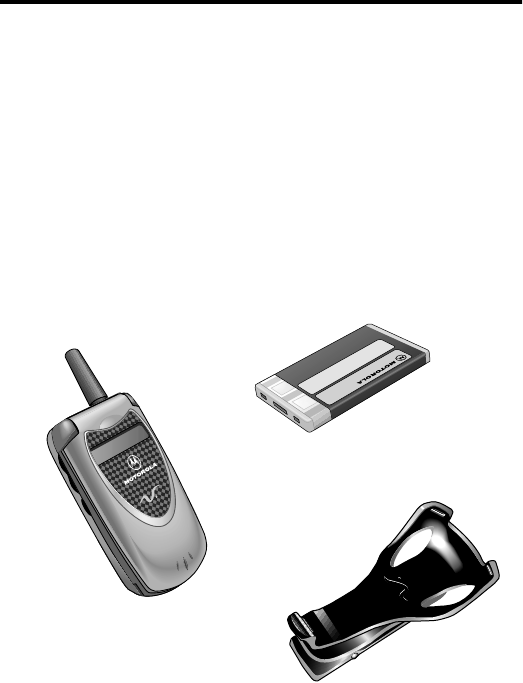
20
Getting Started
What’s in the Box?
Your digital wireless phone typically comes equipped with
a battery and a charger. Other accessory options can
customize your phone for maximum performance and
portability. The following illustrations shows the standard
package contents.
Note: Your phone and accessories may not look exactly
as pictured.
Motorola
Telephone
Lithium Battery
Belt Clip

21
Getting Started
Installing the Battery
Before you can use your phone, you need to install and
charge the battery.
Your phone is designed to be used only with
Motorola Original™ batteries and accessories.
We recommend that you store batteries in their
protective cases when not in use.
Do This
1
Remove the battery from
its protective clear plastic
case.
Rapid Travel Charger

Getting Started
22
2
Push down the battery
door release latch and lift
the battery door off of the
phone.
3
Insert the battery, printed
arrows first, into the
battery compartment and
push down.
4
Replace and close the
battery door.
Do This
Release
latch

23
Getting Started
Charging the Battery
Before you can use your phone, you need to install and
charge the battery.
Tip: When your phone is turned on, the battery level
indicator in the upper right corner of the phone display
shows the amount of charge left in your battery. (See the
“Battery Level Indicator” item on page 29.)
Do This
1
Plug the rapid travel
charger into your phone
with the release tab
facing up.
2
Plug the other end of the
rapid travel charger into
the appropriate electrical
outlet.
3
When your phone
indicates that the battery
is fully charged, press the
release tab and remove
the rapid travel charger.
Illustration
to come
Charge Complete
PH BOOK MESSAGE
M
5E

Getting Started
24
Turning Your Phone On
Sending a Call
To call a number, your phone must be turned on, be
unlocked, and have a network connection with adequate
Do This To
1
Open your phone expose the keypad
2
Press and hold P
(the power key)
turn on your phone
3
Enter your four-digit
unlock code and
press OK (+)
unlock your phone, if
necessary
The unlock code is originally
set to 1234. (For more
information, see “Locking
and Unlocking Your Phone”
on page 129.)
Power
key

25
Getting Started
signal strength.
Ending a Call
Receiving a Call
To receive a call, your phone must be turned on and have
a network connection with adequate signal strength. If
your phone is locked, you must unlock the phone to
answer the call.
Do This To
1
Extend the
antenna
optimize signal reception
2
Press the
keypad keys
dial the phone number (up to 32
digits)
Tip: If you make a mistake, press
DELETE (-) to delete the last
digit, or press and hold
DELETE (-) to clear all digits.
3
Press N
(send key)
send the call
Press To
O (end key) end the call

Getting Started
26
When you receive a call, your phone rings and/or vibrates
and displays an incoming call message.
Displaying Your Phone Number
Press To
N or ANSWER (+)answer the call
Press To
M #see your phone number

27
About Your Phone
See the inside cover page for a diagram of your phone
that describes basic phone components.
Display
The top section of the display shows phone status
indicators. The following illustration shows some of the
common indicators that you may see at the top of the
display when using your phone.
Messages, phone numbers, and menu options appear in
the middle of the display. Text labels at the bottom of the
display show the current soft key and menu key functions.
For a description of the soft key and menu key labels, see
“Using the Menu” on page 48.
Some of the phone functions described in this guide must
be performed from the idle display. The term
idle display
refers to the standard display that you see when your
phone is on and ready to use, when you are
not
on a call
or using the menu system.

About Your Phone
28
➊ Signal Strength Indicator Shows the strength of
your phone’s connection with the network.
You cannot send or receive calls when the “no signal”
indicator is displayed.
➋ In Use Indicator Appears when a call is in progress.
➌ Roam Indicator Appears when your phone uses
another network system outside your home network.
When you leave your home network area, your phone
roams
or seeks another network.
Strong 5 4 3 2 1 j No signal
E
w12:00
O,&X
F
5
➊Signal
Strength
Indicator
Clock
➏Battery
Level
Indicator
➑Digital/
Analog
Signal
Indicator
➋In Use
Indicator
➌Roam
Indicator
➍Message Waiting
Indicator
➎Voice Message
Waiting Indicator
➐Alert Setting
Indicator

29
About Your Phone
➍ Message Waiting Indicator Appears when
your phone receives a text message.
➎ Voice Message Waiting Indicator Appears
when your voicemail receives a message.
➏ Battery Level Indicator Shows the amount of
charge left in your battery. The more segments visible, the
greater the charge.
Recharge your battery as soon as possible when you see
the Low Battery warning message.
➐ Alert Setting Indicator Shows the current selected
alert. The default alert setting is a ringer.
➑ Digital (F) or Analog (I) Signal Indicator
Shows whether you are receiving a digital or analog
signal.
High E D C B Empty
w Loud ring x Soft ring
y Vibrate v Ring and vibrate
t Silent
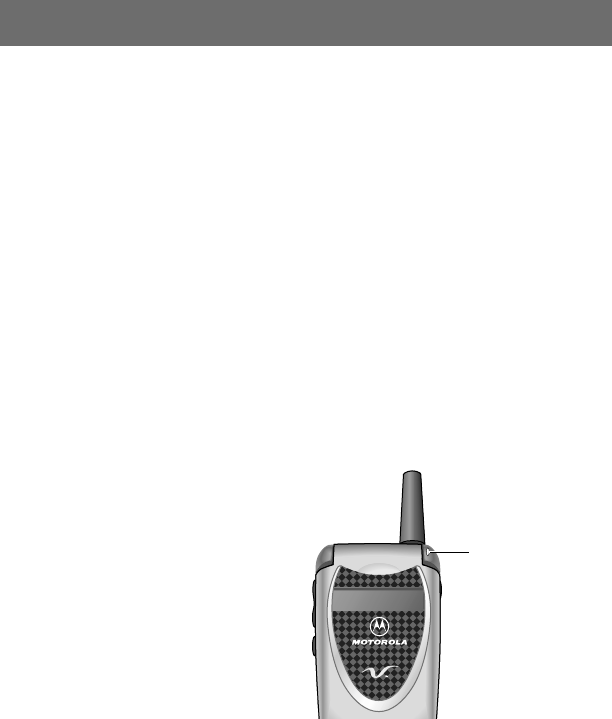
About Your Phone
30
Adjust Zoom Setting
You can set your phone’s display to show either three lines
or two lines of text plus soft key labels. Three lines of text
display more information, while two lines increase text
size to improve readability.
To change the display view from the idle display or while
in a menu application:
Press M once, then press and hold M again within
two seconds of the first press.
You can also set the display zoom factor from the menu.
See the “Zoom” item on page 62.
Status Light
The status light tells you
when you have an
incoming call or
message, or when your
phone is “roaming”
(using a non-home
system). The light
Status
light
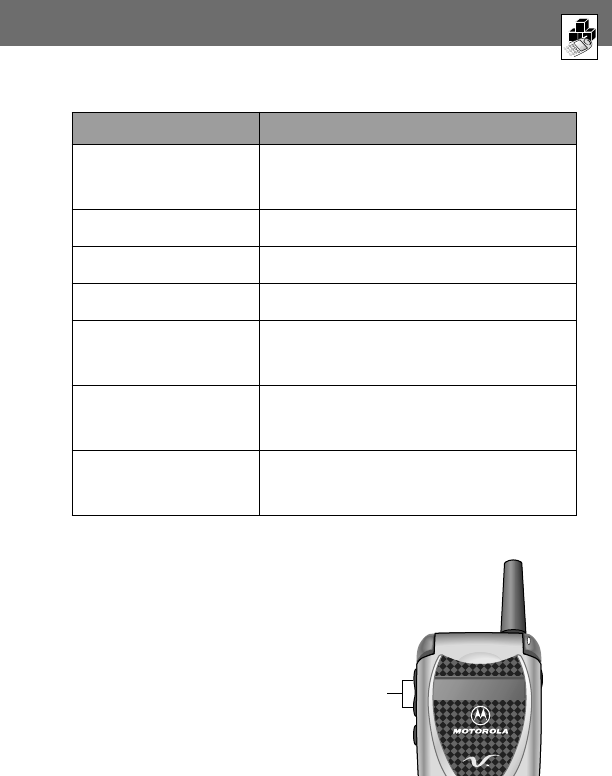
31
About Your Phone
changes color to indicate different states:
Volume Keys
Use the upper and
lower volume keys to
adjust your phone’s
earpiece and ringer
volume.
Indication State
alternating red/
green (fast)
incoming call
flashing green in service, home-type system
flashing yellow roaming, non-home-type system
flashing red (slow) no service
flashing red (fast) text or voicemail message
received, but no service
alternating green
(short)/red (long)
text or voicemail message
received, home service
alternating yellow
(short)/red (long)
text or voicemail message
received, roaming service
Volume
keys

About Your Phone
32
You can also use the volume keys to scroll up or down
through menus and lists.
To change keypad volume, see “Select a Ring/Vibration
for a Specific Event” on page 115.
Smart Key
The smart key gives
you another way to
perform many basic
phone functions. It’s
called the smart key
because it anticipates
the next action you
are likely to perform.
For example, if you
highlight an item and press the smart key, the smart key
selects the highlighted item. You can use the smart key to
send and end calls, select menu items, toggle features on
When Press To
During a call volume keys increase or decrease
earpiece speaker volume
When you are
not on a call
volume keys increase or decrease
ringer volume
External
display
Volume
keys
Smart
key

33
About Your Phone
and off, and open your phonebook. The smart key usually
performs the same function as the right soft key (+).
You can also use the smart key to perform specific
functions in the external display when your flip is closed.
See the following section for details.
External Display
When your phone is on and the flip is closed, the external
display shows the time and date. It also displays messages
to notify you of events (like incoming calls) that need your
attention.
Set Phone Alert
To change your phone’s alert in the external display:
Return an Unanswered Call
When you cannot answer a call, your phone keeps a
record of your unanswered calls and displays the message
Press To
1
volume keys scroll to Alert
2
smart key select an alert type
3
volume keys return to the idle display

About Your Phone
34
X Missed Calls, where X is the total number of missed
calls. When you see the X Missed Calls message in the
external display:
Note: Because the microphone and earpiece are
unavailable when the phone is closed, you must use a
headset or other hands-free device with this feature.
Battery Use
Caution: To prevent injuries or burns, do not allow metal
objects to contact or short-circuit the battery terminals.
To use your battery to its fullest capacity:
• Always use Motorola approved batteries and battery
chargers. The phone warranty does not cover damage
caused from using non-Motorola batteries and/or
battery chargers.
Press To
1
smart key see the received calls list
2
volume keys scroll through the list and select a
call that you want to return
3
smart key send the call

35
About Your Phone
• New batteries or batteries that have been stored for
long periods of time may require a longer charge
time.
• Maintain the battery at or near room temperature
when charging.
• Do not expose batteries to temperatures below -10°C
(14°F) or above 45°C (113°F). Always take your
phone with you when you leave your car.
• When you do not intend to use a battery for a while,
store it uncharged in a cool, dark, dry place, such as a
refrigerator.
• Over extended periods of time, batteries gradually
wear down and require longer charging times. This is
normal. If you charge your battery regularly and
notice a decrease in talk time or an increase in
charging time, then it is probably time to purchase a
new battery.
• The more you talk on the phone or use phone
features (like sending text messages), the less standby
time your battery has. You can also extend battery life
by turning off the status light. (See the “Status Light”
item on page 62.)

36
Sending and Receiving Calls
For basic instructions on how to send a call, end a call,
and receive a call, see page 24 of the “Getting Started”
section.
Redialing a Number
If you hear an ordinary busy signal, the phone number you
dialed is busy.
Using Automatic Redial
If the network is busy, you hear a fast busy signal, and
your phone displays the message Call Failed along with
the reason for the failure.
With automatic redial, your phone repeats the call
attempt over the next four minutes.
Press To
1
O hang up
2
N redial the busy number
Press To
N or RETRY (+)activate automatic redial

37
Sending and Receiving Calls
When the call goes through, your phone rings or vibrates
once, displays Redial Successful, and then connects the
call automatically.
Caller ID
The
calling line identification
(caller ID) feature lets
you see who is calling before you answer.
• If the caller’s name is stored in your phonebook, the
phone automatically displays the name. Otherwise,
the phone displays the caller’s phone number.
• If caller ID information is not available, your phone
displays the message Incoming Call.
Returning an Unanswered Call
When you cannot answer a call, your phone keeps a
record of your unanswered calls and displays:
• the T (missed calls) icon
• the message X Missed Calls Y Unknown, where X is
the total number of missed calls and Y is the number
of missed calls for which caller ID information is not
available.

Sending and Receiving Calls
38
Dialing an Emergency Number When
the Phone is Locked
Your service provider programs one or more emergency
phone numbers that you can call even if your phone is
locked or restricted.
Entering Numbers in the Notepad
Your phone stores the most recent string of digits entered
on the keypad in a temporary memory location called the
Press To
1
VIEW (+) see the received calls list
2
S scroll through the list and select a
call that you want to return
3
N send the call
Press To
1
any keypad key display the enter code or locked
prompt
2
keypad keys dial the emergency number (such
as 911)
3
N call the emergency number

39
Sending and Receiving Calls
notepad
. These digits can be the last phone number that
you called, or a phone number that you simply entered
but did not call. Even when you turn off the phone, these
digits remain in the notepad.
You can use the notepad to store a phone number that
you intend to call later (such as a phone number told to
you by the other party during an active call). To retrieve
these digits, see “Using the Notepad” on page 72.
Canceling the Ring or Vibrate Alert
While the phone is ringing or vibrating:
Depending on your phone settings and the type of
subscription you have with your service provider, the call
may be forwarded, or the calling party may hear a busy
signal. To specify a ring or vibrate type, see “Ring/Vibrate”
on page 115.
Dialing With Speed Dial
The
speed dial
feature lets you dial any phonebook entry
with a mimimal number of keypresses.
Press To
O or IGNORE (-)cancel the ring or vibrate alert

Sending and Receiving Calls
40
Whenever you store an entry in your phonebook, the entry
is assigned a unique speed dial number. If you know the
speed dial number for the phonebook entry you want to
call, you can use the speed dial feature.
To make an entry in the phonebook or view an existing
entry’s speed dial number, see “Storing a Phonebook
Entry” on page 76.
Dialing With One-Touch Dial
You can call phonebook entries 2 through 9 with the push
of a single key:
Press and hold the one-digit speed dial number for one
second.
You
cannot
use one-touch dial to call phonebook entry
number 1, since the 1 key is reserved for dialing your
voicemail number. See “Listening to a Voicemail
Message” on page 93.
Press To
1
keypad keys enter the one-, two-, or three-digit
speed dial number for the entry
you want to dial
2
N call the entry

41
Sending and Receiving Calls
To store entries in locations 2 through 9 in the
phonebook, see “Storing a Phonebook Entry” on
page 76.
Note: You must activate the one-touch dial feature before
you can use it. See the “One-Touch Dial” item on
page 61.
Dialing a Number In a Text Message
If the phone lists more than one number for the message,
press S to scroll to a number and then press
SELECT (+) to dial.
Find the Feature
M> Messages
> Text Msgs
Press To
1
S scroll to the message with the
number
2
M open the text message menu
3
S scroll to Call Back
4
SELECT (+) dial the number in the message

Sending and Receiving Calls
42
Note: You must set up your inbox before opening text
messages. See “Setting Up the Text Message Inbox” on
page 94.
Additional Dialing Features
In addition to pressing numbers on your keypad, you can
insert numbers or characters and send calls in a variety of
ways.
Do This To
Press 0 for two
seconds
insert the international access
code for the country from which
you are calling
Press M
> Attach Digits attach digits to precede the
phone number you are calling
Press M
> Add Digits add digits to follow the phone
number you are calling

43
Sending and Receiving Calls
Press M and then
scroll to and select
one of the following:
•Insert Pause
(to insert a p)
•Insert Wait
(to insert a w)
•Insert 'n'
(to insert an n)
insert a special character when
making a calling card call:
• Pause tells your phone to
wait until the call connects
before it sends the next digit.
• Wait tells your phone to wait
until the call connects, then
prompt you before it sends
the next digit.
• 'n' tells your phone to stop
and prompt you for a number
before it sends the next digit.
Press M
> Send Message create a text message addressed
to the number entered
Do This To

Sending and Receiving Calls
44
You can also call numbers using these features:
Do This To Call
Press the voice key and say the
name (in two seconds).
a phone number using
the voice dial feature
See “Recording a
Voice Name For a
Phonebook Entry” on
page 78.
Press M > Recent Calls
> Received Calls or
Dialed Calls >
entry to call
a missed call or a
number from a call you
recently dialed or
received

45
Using Features While On a
Call
Using Call Waiting
If you subscribe to call waiting, you may hear a
tone while you are on a call. This tone indicates
that you have received a second call.
To put the first call on hold and answer the second call:
To end the first call and answer the second call:
Press To
1
N answer the new call
2
N switch back to the first call
Press To
1
O end the current call
Your phone rings to signal the
new call.
2
N answer the new call

Using Features While On a Call
46
Making a Three-Way Call
During a call, you can call and connect a third
party so that the three of you can talk together.
You cannot do this if you already have a call on
hold.
During a call:
Additional On-Call Features
While you are on a call, you can perform the following
tasks:
Press To
1
keypad keys enter the third person’s number
2
N call the number and connect the
new person
3
N connect the two calls
4
O end the entire call
Do This To
Press M > Mute
or
Press MUTE (+)
(if available)
mute a call
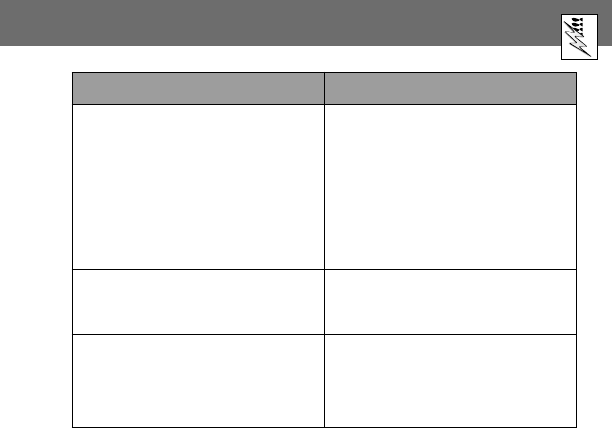
47
Using Features While On a Call
Press M
> Spkrphone On
or
Press SPEAKER (+)
(if available)
activate the speakerphone
(hands-free mode)
Press M
> My Tel. Number see your phone number
Press M > Send Tones send a number as DTMF
tones, for credit card
calling or password entry
Do This To

48
Using the Menu
Navigating to a Feature
You can access many of your phone’s features by using
these keys to move through the menu system:
Main Menu
Recent Calls
Phonebook
EXIT SELECT
E5
Menu Key
Enter the menu
system.
Right Soft Key
Perform the
function shown
in the lower
right corner of
the display
(usually
SELECT
the highlighted
menu item).
Left Soft Key
Perform the
function shown
in the lower left
corner of the
display (usually
EXIT
or
BACK
).
Scroll Key
Move up or
down through
menus and lists.
* and #
Cycle through
and set the
value of the
highlighted
menu item.
End Key
Exit the menu
system without
making changes.
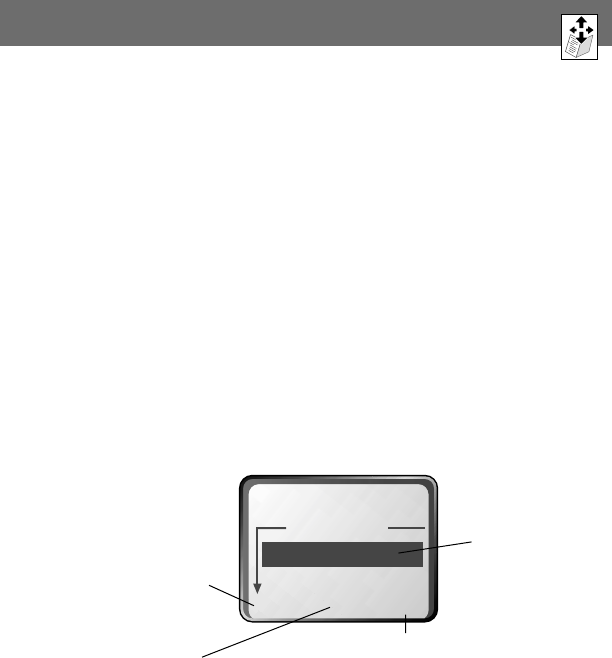
49
Using the Menu
This guide shows you how to navigate to a specific menu
feature as follows:
The > symbol means that you should scroll to and select
the feature. This example shows that you must press
M, scroll to and select Recent Calls, then scroll to
and select Dialed Calls to see the dialed calls list.
Selecting a Feature Option
Some features require you to select an item from a list:
Select an item by highlighting it. Use one of the following
approaches:
Find the Feature
M> Recent Calls
> Dialed Calls
Dialed Calls
10) John Smith
9) Mary Smith
BACK VIEW
Press
BACK
(
-
) to
go back to the
previous screen.
Press
M
to
open a sub-menu.
Highlighted
item
Press
VIEW
(
+
) to view details
of the highlighted item.
STORE
(
+
) appears if you can
store the item in your phonebook.
M
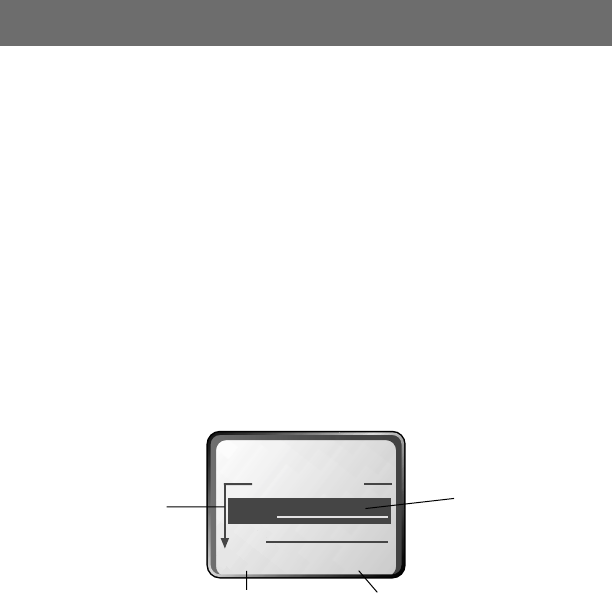
Using the Menu
50
• Press S to scroll up or down to the item you want.
• In a numbered list, press a number key to highlight
the item.
• In an alphabetized list, press a key multiple times to
cycle through the letters on the key and highlight the
closest matching list item.
Entering Feature Information
Features such as the phonebook and datebook require
you to enter information to fill in an entry’s details:
• Enter numbers or text with the keypad. (See “Entering
Text” on page 53.)
Entry Details
Name:John Smith
No.:2125551212
CANCEL CHANGE
Press
S
to
scroll down
to additional
items.
Press
CANCEL
(
-
) to exit
without making changes.
DONE
(
-
) appears when you
enter or edit information. Press
DONE
(
-
) to save your changes.
Press
CHANGE
(
+
)
to edit the selected
information.
Highlighted
selection

51
Using the Menu
• When an item has a list of possible values, press
* and # to scroll through and select a value.
• When an item has a list of possible numeric values,
press a number key to set the value.
• If you enter or edit information and then decide that
you do not want to save your changes, press O to
exit without saving.
The message center lets you compose and send text
messages. (See “Entering Text” on page 53.) A
flashing
cursor
shows you where the text will appear:
Msg:
___________________
____________________
CANCEL BROWSE
Press
BROWSE
(
+
)
to view and
insert a name,
number, or
message from a
preexisting list.
Press
CANCEL
(
-
) to exit
without making changes.
Flashing
cursor
indicates
insertion
point.
Press
M
to open
the sub-menu.
M

Using the Menu
52
When you enter text, the flashing cursor changes to a
block cursor
, and the soft key functions change:
Msg:
T __________________
____________________
DELETE OK
Press
OK
(
+
)
to accept and
store the data.
Press
DELETE
(
-
) to
delete the character to the
left of the insertion point.
Block
cursor
indicates
current
highlighted
character.
M
After two seconds, the
block cursor reverts to a
flashing cursor and moves
to the next position.
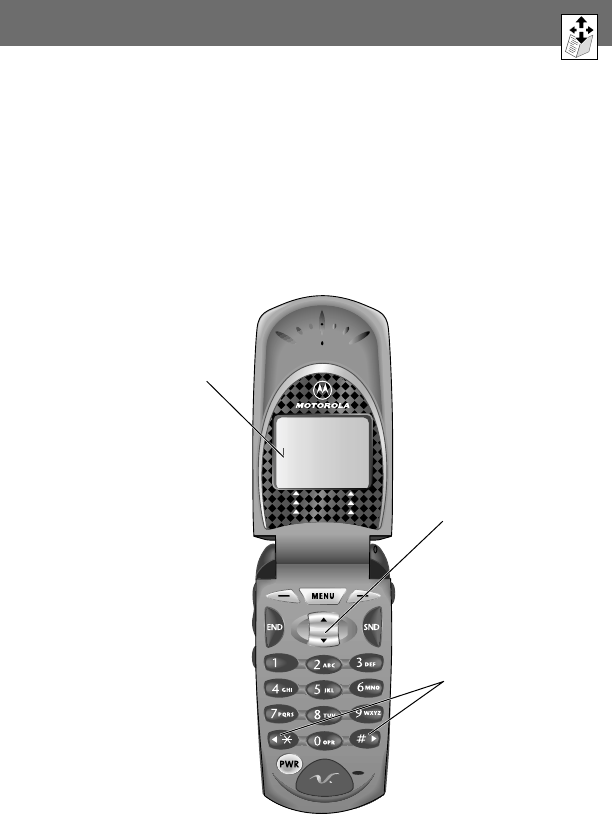
53
Using the Menu
Entering Text
General Text Entry Rules
Use the keypad to enter letters, numbers, and other
characters. Press the same key repeatedly to cycle through
available characters (see “Character Chart” on page 54):
Msg:
__________________
___________________
CANCEL BROWSE
M
Move flashing
cursor to the
left or right.
Move flashing
cursor up or
down one line,
or change
character in
block cursor to
uppercase or
lowercase.
Press a number
key to enter
text at flashing
cursor location.
Press a number
key as many
times as
necessary to
enter the
desired
character.
Press and hold
a number key to
cycle between
uppercase and
lowercase
characters.

Using the Menu
54
• If you do not press a key for two seconds, the
character in the block cursor is accepted, and the
cursor moves to the next position.
• The first character of every sentence is capitalized
unless you manually override it. (Hold the number key
or press S down to force the character to lowercase
while it is highlighted by the block cursor.)
Character Chart
Use this chart as a guide for entering spaces, numbers,
letters, and other characters. Press and hold a key to cycle
between uppercase and lowercase characters.
1
space
. 1 ? ! , @ _ & : " ( ) ' ¿ ¡ % £ $ ¥
2 A B C 2 Ä Å à α β Ç
3 D E F 3 ∆ É è Φ
4 G H I 4 Γ ì
5 J K L 5 Λ
6 M N O 6 Ñ Ö Ø Ò Ω
7 P Q R S 7 Π ß Σ
8 T U V 8 Θ Ü ù
9 W X Y Z 9 Ξ Ψ
0 + - 0 x * / = > < # §

55
Using the Menu
iTAP™ Predictive Text Entry
The iTAP™ predictive text entry method lets you type the
letters of a word using only one keypress per letter. To use
iTAP, press M and select iTAP when you are prompted
to enter text.
When you select iTAP, the third line of the display
becomes a working area that shows a list of the most
common words and letter combinations based on the keys
you press. The list is updated with each keypress. When
you have entered all the letters of a word, press
* and # or the volume keys to scroll left and right
through the list and select the word you want.
For example, to spell the word “act,” press 2 2 8.
The display shows:
Press
SELECT
(
+
) to
enter the highlighted word
at the insertion point.
Press
DELETE
(
-
)
to clear the last letter
entered.
Flashing
cursor
indicates
insertion
point.
Press
*
and
#
to scroll and see
additional word
choices in the
working area.
___________________
____________________
Cat Act Bat Abu
DELETE SELECT

Using the Menu
56
If the word you are spelling is not in the iTAP dictionary,
an appropriate letter combination may not appear in the
word list. Delete one or more characters until you see an
accurate letter combination, then highlight it to lock that
portion of the word. Continue entering letters and
highlighting letter combinations to spell the word.
• The first word of a sentence is automatically
capitalized, with following words in lowercase. Press
S one or more times to force initial character
capitalization, all uppercase, or all lowercase
characters.
• A space is automatically added after each word.
When you add punctuation, the space before the
punctuation is removed. Press 1 or 0 to enter
punctuation or other characters as shown in the
“Character Chart” on page 54.
• To type a number, enter the first digit and then
highlight it in the working area. Following keypresses
add digits to the number until you press
SELECT (+) to enter the number at the insertion
point.

57
Menu Feature Descriptions
This chapter describes all of your phone’s features in
alphabetical order. Some descriptions also include page
numbers where you can find more detailed information. If
you would like to learn more about a specific feature, see
the Motorola Web site at:
http://www.motorola.com/
or contact the Motorola Customer Call Center at
800-XXX-XXXX.
B
ROWSER
M> Browser
Access Web pages and run Web-based
applications.
The Browser delivers WAP (Wireless Application
Protocol) pages from your service provider directly to
your phone. See “Browser” on page 113.
C
ONNECTION
Connect your phone to a computer or fax
machine to send and receive fax and data calls
on the connected machine. Connect your phone using
a cable or a cable and PCMCIA card.
Incoming Call
M> Settings > Connection
> Incoming Call
Specify the format for the next incoming call. You can
select Fax In Only, Data In Only, or Normal.

Menu Feature Descriptions
58
D
ATEBOOK
M> Datebook
Schedule appointments in the datebook calendar.
You can display events for the week, a day, or details
for a specific event. See “Datebook” on page 84.
I
N-
C
ALL
S
ETUP
Customize settings that provide information during a
phone call, such as timers and call answering options.
Answer Options
M> Settings
> In-Call Setup
> Answer Options
Turn call answering options on or off:
Call Waiting
M> Settings
> In-Call Setup
> Call Waiting
Activate and deactivate call waiting.
When call waiting is activated and another call arrives
while you are on a call, call waiting can play a tone to
notify you of the new call. For information on using
call waiting, see “Using Call Waiting” on page 45.
Multi-Key answer by pressing any key
Open to Answer answer by opening the flip

59
Menu Feature Descriptions
In-Call Timer
M> Settings
> In-Call Setup
> In-Call Timer
Adjust call timer display and beep settings. You can
set your timer to beep at a selected interval during
your calls. (60 seconds is the default.) You can also set
your timer to display one of the following during calls:
M
ESSAGES
M> Messages
Listen to voicemail, send and receive text
messages.
Your
voicemail
records voice messages from people
who call you when you are unavailable. See
“Voicemail” on page 92.
Your phone can also receive
text
messages which may
include text, phone numbers, and Web addresses. See
“Text Messages” on page 94.
MYMOTOROLA
.
COM
M> mymotorola.com
Launch the browser and go to the Motorola
home page.
Time displays the elapsed time for the
current call
Off no in-call display for the timer

Menu Feature Descriptions
60
O
THER
S
ETTINGS
Car Settings
M> Settings
> Other Settings
> Car Settings
Adjust hands-free car kit settings.
When your phone is connected to a car kit or headset
and auto answer is set to on, the phone can
automatically answer calls after two rings, and it can
route calls directly to the car kit or headset. See
“Hands-Free Use” on page 118.
Headset
M> Settings
> Other Settings
> Headset
Adjust headset settings.
Initial Setup
M> Settings
> Other Settings
> Initial Setup
Set many basic phone options:
Animation turns animation off (to conserve
the battery) or on. Animation
makes your phone’s menus move
smoothly as you scroll up and
down.

61
Menu Feature Descriptions
Auto PIN Dial automatically dials your
PIN
Battery Save adjusts the phone’s power usage
characteristics to conserve power
Auto Redial automatically redials calls that fail
due to busy network conditions
Backlight changes the time that the
backlight display is on, usually
triggered by the amount of
ambient light
Contrast
Setting adjusts the contrast setting for
your display
DTMF switches DTMF tones on or off
Language sets the language for phone
menus
Master Clear performs master reset and clears
all user-selectable options,
resettable timer, recent call lists,
and phonebook
Master Reset resets all options back to their
original factory settings
except
for
the unlock and security codes
One-Touch Dial assigns this feature to the first
nine numbers in your phonebook

Menu Feature Descriptions
62
Network
M> Settings
> Other Settings
> Network
View and adjust your phone’s network settings.
Your service provider registers your phone to a
network. You may need to change the network
registration to do things like connecting to a TTY
device or using your phone as a wireless modem.
Personalize
M> Settings
> Other Settings
> Personalize
Set several personal phone options:
Scroll forces the cursor to stop or wrap
around when it reaches the top or
bottom of a list in the display
Status Light turns the status light off (to
conserve battery power) and on
Time and Date set the phone’s time and date
Zoom switches to three or two lines of
display text
Banner changes the text that appears in
the idle display
Greeting changes the text displayed when
you turn on your phone

63
Menu Feature Descriptions
P
HONE
S
TATUS
Battery Meter
M> Settings
> Phone Status
> Battery Meter
View a detailed battery charge meter.
My Tel. Number
M> Settings
> Phone Status
> My Tel. Number
View, enter, and edit your name and phone number.
Other Information
M> Settings
> Phone Status
> Other Information
View the phone’s feature specifications (if available
from the service provider).
Keys changes the functions of the soft
keys in the inactive state (See
“Customizing a Soft Key
Function” on page 118.)
Main Menu changes the order of the main
menu (See “Reordering Menu
Items” on page 117.)
Quick Dial changes quick dial number(s)

Menu Feature Descriptions
64
Phone: Line 1/2
M> Settings
> Phone Status
> Phone: Line 1/2
Change the active phone line (on dual-line phones) to
send or receive calls from either of the available
numbers.
P
HONEBOOK
M> Phonebook
Open the phonebook list, where you can call or store
numbers.
You can store names and phone numbers as entries in
your phonebook. Then, you can call phonebook
entries by selecting them from the phonebook list.
See “Phonebook” on page 75.
Q
UICK
D
IAL
M> Quick Dial
Dial pre-programmed customer service
numbers.
Your service provider may program one or more quick
dial numbers, such as the customer service number,
into your phone. You can call them by selecting them
from the quick dial list.
Note: Your service provider may use a different name
for this feature.

65
Menu Feature Descriptions
R
ADIO
M> Radio
Listen to FM radio stations with the optional
Motorola FM stereo headset accessory. This
menu feature is displayed only when the FM stereo
headset is plugged into the accessory connector port
on your phone. See “Radio” on page 90.
R
ECENT
C
ALLS
See “Recent Calls” on page 69.
Call Times
M> Recent Calls
> Call Times
View call timers.
You can view five timers that track time spent on your
last call, dialed calls, received calls, all calls since
reset, and all calls total. See “Viewing and Resetting
Call Timers” on page 74.
Dialed Calls
M> Recent Calls
> Dialed Calls
View a list of recently dialed calls.
Your phone keeps a list of phone numbers from calls
you recently dialed (even if the calls did not connect).
See “Viewing the Received Calls or Dialed Calls List”
on page 69.

Menu Feature Descriptions
66
Notepad
M> Recent Calls
> Notepad
Call or store the last number entered on the keypad.
You can use this notepad to view the last number you
entered, even if you did not call the number. See
“Using the Notepad” on page 72.
Received Calls
M> Recent Calls
> Received Calls
View a list of recently received calls.
Your phone keeps a list of the numbers from calls you
recently received (even if you did not answer). See
“Viewing the Received Calls or Dialed Calls List” on
page 69.
R
ING
/V
IBRATE
Alert
M> Settings
> Ring/Vibrate
> Alert
Select a type of ring or vibration alert for incoming
calls and messages. See “Ring/Vibrate” on page 115.
Alert Detail
M> Settings
> Ring/Vibrate
>
Alert
Detail
Change details about the ring or vibration alert.
Alert
represents the name of the current alert setting. See
“Ring/Vibrate” on page 115.

67
Menu Feature Descriptions
S
ECURITY
Lock Application
M> Settings > Security
> Lock Application
Lock and unlock specific phone applications (such as
phonebook and datebook) so that users must enter
the unlock code to use them.
Lock Keypad
M> Settings > Security
> Lock Keypad
Lock and unlock your keypad. See “Locking and
Unlocking Your Keypad” on page 130.
New Passwords
M> Settings > Security
> New Passwords
Change your unlock code (originally set to 1234) or
your security code (originally set to 000000). See
“Restricting Calls” on page 131.
Phone Lock
M> Settings > Security
> Phone Lock
Lock and unlock your phone. See “Locking and
Unlocking Your Phone” on page 129.
Restrict Calls
M> Settings > Security
> Restrict Calls
Restrict incoming and outgoing calls. See “Restricting
Calls” on page 131.

Menu Feature Descriptions
68
Talk Secure
M> Settings > Security
> Talk Secure
Indicate a preference for secured voice channels, so
that your phone tells you if a voice channel is not
secure.
S
HORTCUTS
M> Shortcuts
Create keypad or voice shortcuts to menu features.
See “Shortcuts” on page 101.
V
OICE
N
OTES
M> VoiceNotes
Use the voice key to record messages and phone calls.
See “Voice Notes” on page 107.

69
Recent Calls
You can use the recent calls menu to view or delete
received calls or dialed calls, or to retrieve the last number
stored in the notepad.
Viewing the Received Calls or Dialed
Calls List
Your phone keeps lists of the numbers from calls you
recently received and dialed, even if the calls did not
connect. The lists are sorted from newest to oldest entries.
The oldest entries are deleted as new ones are added.
Each entry tells you the person’s number (or name, if
available) and whether the call connected or not. You can
call, store, or delete the numbers on these lists.
Shortcut: Press N to go directly to the dialed calls list
from the idle display.
Find the Feature
M> Recent Calls
Press To
1
S scroll to Received Calls or
Dialed Calls
2
SELECT (+) select Received Calls or
Dialed Calls

Recent Calls
70
3
S scroll to an entry you want to call,
store, or delete
Note: L means the call
connected
4
N call the entry number
Tip: Press and hold N for two
seconds to send the entry number
as DTMF tones.
or
+ view the entry’s details if View
appears above the + key, or
store the entry’s details in the
phonebook if Store appears
above the + key
or
M open the last calls menu to
perform other procedures as
described in the following list
Press To

71
Recent Calls
The last calls menu includes the following options:
Option Description
Store Create a phonebook entry with the
selected number in the Tel No. field.
(This option is not available if STORE
appears above the + key.)
Delete Delete the entry. (This option is not
available if DELETE appears above the
- key.)
Delete All Delete all entries in the current list.
Send Message Create a new message, with the
selected number in the Tel No. field.
See “Sending a New Text Message”
on page 99.
Add Digits Add digits to the end of the selected
number. See “Additional Dialing
Features” on page 42.
Attach Number Attach digits to the beginning of the
selected number. See “Additional
Dialing Features” on page 42.
Send Tones Send DTMF tones (only with a call in
progress). See “Additional On-Call
Features” on page 46.

Recent Calls
72
Using the Notepad
Your phone uses a notepad to store the most recent string
of digits entered—either for a phone number that you
called or for a number that you entered but did not call.
You can use the digits in the notepad to make a call or
create a phonebook entry.
Find the Feature
M> Recent Calls
> Notepad
Press To
N call the number stored in the
notepad
or
M open the dialing menu (to attach a
number or insert a special
character). See “Additional Dialing
Features” on page 42.
or
STORE (+) open a new phonebook entry form,
with the notepad number copied
into the Tel No. field. See “Storing
a Phonebook Entry” on page 76.

73
Call Timers
You can use the recent calls menu to view or reset call
timers.
Using Call Timers
Network connection time
is the elapsed time, in
one-minute intervals, from the moment you connect to
your service provider’s network to the moment you end
the call by pressing O. The time includes busy signals and
ringing.
The amount of network connection time you track on your
resettable timer may not equal the amount of time for
which you are billed by your service provider. For billing
information, please contact your service provider directly.
You can view the approximate network connection time
elapsed during the following calls:
Timer Description
Last Call time spent on the last call dialed or
received. You cannot reset this timer.
Dialed
Calls total time spent on dialed calls since the
last time you reset this timer
Received
Calls total time spent on calls received since the
last time you reset this timer

Call Timers
74
Viewing and Resetting Call Timers
To view a call timer:
To reset the call timer:
All Calls total time spent on dialed and received
calls since the last time you reset this timer
Lifetime total time spent on all calls on this phone.
You cannot reset this timer.
Find the Feature
M> Recent Calls
Press To
1
S scroll to Call Times
2
SELECT (+) open the list of timers
3
S scroll to the timer you want to see
4
SELECT (+) select the timer and display the
time recorded on it
Press To
1
RESET (+) reset the time (if available)
2
YES (+) confirm the reset
Timer Description
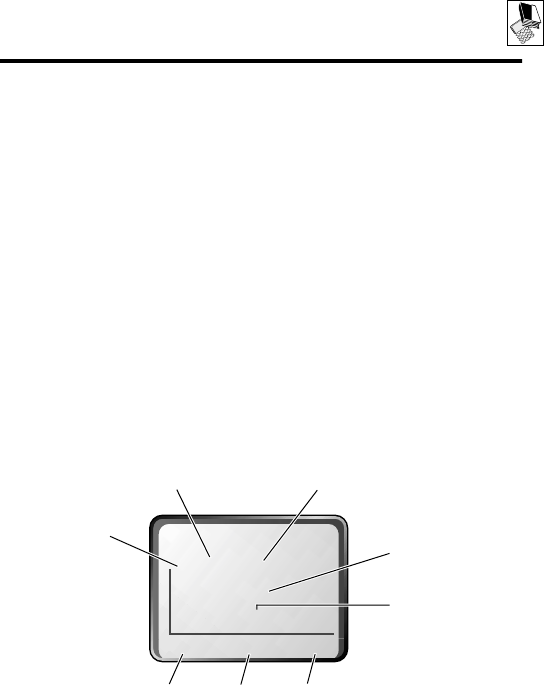
75
Phonebook
You can store a list of names and phone numbers in your
phone’s electronic phonebook. Your phone can store as
many as 1000 entries. You can view these entries and call
them directly from your phone.
You can view the list of names stored in your phonebook
by pressing M > Phonebook from the idle display.
Scroll to a name and press VIEW (+) to view details of
the phonebook entry as shown in the following display.
Fields in a Phonebook Entry Form
$*Carlo Emrys
2154337215
Speed No.15
BACK EDIT
No.
is the
phone number.
Type
icon
identifies
number
type:
$
Work
U
Home
S
Main
h
Mobile
Z
Fax
p
Pager
Voice Name
icon indicates
a recorded voice name. Entry’s
Name
or
Speed Dial Number
.
Edit
entry
Open
phone
menu
Return
to list
M
Speed Dial
Number

Phonebook
76
Storing a Phonebook Entry
Enter Required Information
A name and number are required for a phonebook entry.
Enter Optional Information
Continue by entering optional information, if needed.
Find the Feature
M> Phonebook
M> New
Press To
1
CHANGE (+) select Name
2
keypad keys enter a name for the phonebook
entry (See “Entering Text” on
page 53.)
3
OK (+) store the name
4
CHANGE (+) select No.
5
keypad keys enter the phone number
6
OK (+) store the phone number
Press To
1
CHANGE (+) select Type:

77
Phonebook
2
S scroll to the type of phone number
3
SELECT (+) select the number type
4
OK (+) store the number type
5
S scroll to Speed No., the number to
“speed dial” the entry
The next available speed dial
number is assigned to new
phonebook numbers by default.
6
SELECT (+) select Speed No. if you want to
change it
7
keypad keys enter a different speed number, if
desired
8
OK (+) save the modified speed number
If your chosen speed number is
already assigned to another entry,
you are asked if you want to
replace that entry.
9
SELECT (+) select MORE if you want to create
another entry with the same Name
Press To

Phonebook
78
Complete Phonebook Entry
When you are finished entering information for a
phonebook entry:
Recording a Voice Name For a
Phonebook Entry
After you store a phonebook entry, you can record a voice
name for it. This lets you use voice dial to call the number
without dialing (see “Voice Dial” on page 80).
Your phone can store a total of four minutes of voice
recordings (including voice notes, voice names, and voice
shortcuts). Each voice name uses two seconds of
recording time.
Press To
DONE (-) store the entry and return to the
phonebook list
Find the Feature
M> Phonebook
Press To
1
S scroll to the entry that needs a
voice name
2
VIEW (+) display the entry’s detailed view

79
Phonebook
Dialing a Phonebook Entry
You can use the phonebook list, voice dial, speed dial, or
one-touch dial to call the numbers stored in your
phonebook. To use speed dial, see “Dialing With Speed
Dial” on page 39. To use one-touch dial, see “Dialing
With One-Touch Dial” on page 40.
3
EDIT (+) edit the phonebook entry
4
S scroll to Voice Name
5
RECORD (+) record a voice name
The phone displays Press Voice
Key then say name.
6
voice key and
say the entry’s
name in two
seconds
record the voice name
The phone displays Press Voice
Key then REPEAT name.
7
voice key and
repeat the name
confirm the voice name
The phone displays Trained: Voice
Name.
Press To

Phonebook
80
Phonebook List
To call a number from the phonebook list:
Voice Dial
To call a number using voice dial:
Find the Feature
M> Phonebook
Press To
1
S scroll to the entry you want
to call
2
N send the call
Do This Result
Press the voice key
and say the entry’s
name in two
seconds to go to
the entry in the
phonebook list
Your phone plays back the voice
name stored with the phonebook
entry, waits two seconds, then
automatically dials the call.

81
Phonebook
Editing a Phonebook Entry
Edit information in a phonebook entry by following the
procedures described in “Storing a Phonebook Entry” on
page 76.
Deleting a Phonebook Entry
To delete a phonebook entry:
Find the Feature
M> Phonebook
Press To
1
S scroll to the entry you want to edit
2
VIEW (+) display the entry’s detailed view
3
EDIT (+) edit the phonebook entry
Find the Feature
M> Phonebook
Press To
1
S scroll to the entry you want to
delete
2
M open the phonebook menu
3
S scroll to Delete
4
SELECT (+) select Delete

Phonebook
82
Checking Phonebook Capacity
You can check your phonebook’s capacity to see how
many entries you have used and how many more are
available. Your phonebook holds 1000 speed dial
numbers.
To check the phonebook capacity for your phone:
Synchronizing with TrueSync Software
You can synchronize phonebook entries between
your phone and computer with TrueSync®
5
YES (-) confirm the deletion
Find the Feature
M> Phonebook
Press To
1
M open the phonebook menu
2
S scroll to PhBook Capacity
3
SELECT (+) select Phbook Capacity
The phone displays the number of
entries in use and the number that
are empty
Press To

83
Phonebook
software, a Motorola accessory product. See the TrueSync
user guide for more information.
Setting Up the Phonebook
You can set up your phone to sort your phonebook list by
speed dial number (the standard), name, or voice dial.
Tip: The voice dial sort is identical to the name sort,
except that the entries with voice name tags appear first.
Find the Feature
M> Phonebook
Press To
1
M open the phonebook menu
2
S scroll to Setup
3
SELECT (+) select Setup
4
S scroll to Sort by
5
CHANGE (+) select Sort by
6
S scroll to the entry you want
7
SELECT (+) select the entry you want

84
Datebook
The datebook lets you schedule and organize
appointments and keep track of special events. It can
display and notify you of events for the week, a day, or
details for a specific event. To schedule or see events.
The datebook is organized by
views
—from the week
view, to the day view, to a view of a specific event. By
pressing VIEW (+), you can move from one view to
another.
Week View
When you open the datebook, your phone displays a
calendar for the week. Lines or filled boxes under each
day indicate that events have been scheduled.
Find the Feature
M> Datebook
EXIT VIEW
{15 NOV-21 NOV }
Go to
highlighted day
Open
menu
Exit the
datebook
Untimed
event
12 hour
window One-hour event
Days of week
(press
*
or
#
to select)
M
Full day (12-hour)
event scheduled
S M T W T F S

85
Datebook
Day View
From the week view, press VIEW (+) to see the day’s
events. You can store, edit, view, copy, and delete any
event from the day view.
Event View
From the day view, press VIEW (+) to open the detailed
event view. You can edit, copy, and delete events from the
event view.
Day of week
Show event
details
Open menu
Return to
previous screen
Untimed
event Event
Alarm
Down scroll
arrow
• Joe’s B-day
9:00 A Marie,...
BACK VIEW
THU 19-NOV
M
Date and time
Edit event
Open menu
Return to
previous screen
Event details
Alarm
Down scroll
arrow
Marie, mtg about
new product
(1 hrs)
BACK EDIT
A THU 9:00 am
M

Datebook
86
Storing a New Event
See “Selecting a Feature Option” on page 49 for
instructions on scrolling to and selecting options.
Find the Feature
M> Datebook >
day
M> New
Press To
1
CHANGE (+) select Title
2
keypad keys enter a title for the event (see
“Entering Text” on page 53.)
3
OK (+) store the event title
4
S scroll to other fields and enter
information as necessary
Select an entry detail to enter
information. A title is required.
Other details includes time,
duration, date, repeating events,
and alarms.
5
DONE (-) store the new event and return to
the week view
HELP?

87
Datebook
Changing Event Information
To change information about an existing event:
Copying an Event
To copy information from a current event to a new event:
Find the Feature
M> Datebook
Press To
1
* or #scroll to the scheduled event day
2
VIEW (+) display the day view
3
S scroll to the event you want to
change
4
VIEW (+) display the event view
5
EDIT (+) edit the event
6
S scroll to the event detail that
requires change
7
CHANGE (+) edit the information
8
keypad keys enter the new information
9
DONE (-) store the information
Find the Feature
M> Datebook

Datebook
88
Deleting an Event
Press To
1
* or # scroll to the scheduled event day
2
VIEW (+) display the day view
3
S scroll to the event to copy
4
M open the event menu
5
S scroll to Copy
6
SELECT (+) copy the event
7
YES (-) confirm the copy
The phone assumes that you want
to change the date and displays
the Date: field.
8
keypad keys enter the date information
9
--> (+) move to the month, day, and year
10
DONE (-) save the copy of the event
11
BACK (-) return to the day view
Find the Feature
M> Datebook

89
Datebook
Press To
1
* or #scroll to the scheduled event
day
2
VIEW (+) display the day view
3
S scroll to the event to delete
4
M open the event menu
5
S scroll to Delete
6
SELECT (+) select Delete
For non-repeating events, go to
step 7. For repeating events,
the phone displays a delete
event menu:
a
S scroll to This Event Only or
Repeat Events
b
SELECT (+) select the event(s) to delete
7
YES (-) confirm the deletion
The phone briefly displays a
Deleted: message and returns
you to the day view.

90
Radio
Your phone comes with a radio that lets you tune,
store presets, and listen to FM radio stations.
To listen to the radio, you must use the optional
Motorola FM stereo headset accessory. The headset plugs
into the accessory connector port on your phone. The
Radio menu feature is displayed only when the FM stereo
headset is plugged into the accessory connector port.
Turning the Radio On and Off
To turn the radio on or off:
Tuning a Station
To tune a radio station with the radio on:
Find the Feature
M> Radio
Do This To
Press Sscroll up or down to the next
frequency
or
Press and hold Sscroll up or down to the next
available stereo station

91
Radio
Storing a Preset
When you tune the station that you want to save:
Selecting a Preset
To select a preset radio station:
Sending and Receiving Calls with the
Radio On
Incoming calls, messages, and other alerts interrupt the
radio. Turn the radio off before dialing outgoing calls. You
do not have to turn off the radio to dial emergency
numbers, or numbers selected from your phonebook or
other lists.
Do This To
Press and hold
a number key
(1 to 9)
assign its preset number to the
tuned station
Press To
a number key
(1 to 9)
tune the station stored at that
preset location

92
Voicemail
You can listen to your voicemail messages by
calling your network voicemail phone number.
Voicemail messages are stored on the network—
not on your phone. Contact your service provider for more
details.
Storing Your Voicemail Number
Store your voicemail number in your phone to make it
faster and easier to use voicemail. Your voicemail number
is provided by your service provider.
Receiving a New Voicemail Message
When you receive a voicemail message, your phone
displays New VoiceMail &. (Some networks only
indicate when you have messages, whether they are new
Find the Feature
M> Messages
M> VoiceMail Setup
Press To
1
keypad keys enter the phone number for your
voicemail
2
OK (+) store the number

93
Voicemail
or not.) If reminders are turned on, your phone sends a
reminder every five minutes until you close the new
message notification, listen to the message, or turn off
your phone.
From the new message notification:
Listening to a Voicemail Message
To listen to your voicemail messages at any time:
Your phone calls the voicemail phone number you stored.
If you do not have a voicemail number stored, the phone
guides you through storing a number.
Shortcut: You can also press and hold 1 to listen to
your voicemail message(s). A = (voicemail) icon is
printed on the 1 key as a function reminder.
Do This To
Press CALL (+)
or
Press and hold 1
call your voicemail phone number
and listen to the message
Tip: A = (voicemail) icon is
printed on the 1 key as a
function reminder.
Find the Feature
M> Messages
> VoiceMail

94
Text Messages
Text messages are brief messages that you can
enter, send, and receive (such as “Where are we
meeting?”). These messages appear on your
phone display or in your message inbox.
You must set up a text message inbox
before
you can
send and receive these messages. Your inbox can hold up
to 10 text messages. (The total number of messages the
inbox can hold depends on the length of the messages,
and the number of other messages and drafts stored in
your phone.)
Setting Up the Text Message Inbox
Find the Feature
M> Messages
M > Text Msg Setup
Press To
1
S scroll to Service Center No.
2
CHANGE (+) change the Service Center No.
which is provided by your service
provider
3
keypad keys enter the phone number for the
service center that handles your
outgoing messages

95
Text Messages
4
OK (+) store your service center number
5
CHANGE (+) change the Expire After period
6
keypad keys enter the expiration period—the
number of days your network tries
to send unreceived messages
7
OK (+) store the expiration period
8
CHANGE (+) change the Cleanup setting
9
S scroll to the period of time that
messages stay in your inbox
10
SELECT (+) select the cleanup period
If you select Custom, continue.
Otherwise, the procedure is
complete.
11
S change the entry for the number
or label
12
* and #switch between the number and
the label
13
DONE (-) store the custom cleanup period
after you finish entering all
information
Press To

Text Messages
96
Receiving a New Text Message
Note: You must set up your text message inbox before
you can receive text messages.
When you receive a new message, your phone displays
New message X and gives an alert. If reminders are
turned on, your phone sends a reminder every five
minutes until you close the new message notification,
read the message, or turn off your phone. When your
inbox is full, any new message replaces the older
unlocked message.
From the new message notification:
Reading, Locking, or Deleting a Text
Message
You can open your text message inbox to read, lock, or
delete messages at any time.
The text message inbox holds up to 10 messages, sorted
from newest to oldest. The oldest messages are deleted as
new ones are added. If you want to save a message, you
Press To
READ (+) open the message (or your text
message inbox if there are
multiple messages)

97
Text Messages
should lock it to prevent it from being overwritten as new
messages are received.
Find the Feature
M> Messages
> Text Msgs
Press To
1
S scroll to the message you want
(! = unread and urgent,
L = read, f = locked)
2
READ (+) open the message
3
SAVE (-) close the message without
changes
or
DELETE (+) delete the message
or
M open the message menu to
perform other procedures as
described in the following list

Text Messages
98
The message menu includes the following options:
Option Description
Call Back Call the number in the message
header or the message text
Go To Go to a Web address in the
message
Reply Open a new text message, with
the message’s Reply To number in
the To: field
Lock/Unlock Lock or unlock the message
Delete
or
Delete All
Delete the message or all inbox
messages
Press Yes (-) to confirm the
deletion.
Store Number Open a new phonebook entry with
the message’s embedded number
in the No. field
New Open a new text message form
Setup Open the inbox setup menu

99
Text Messages
Sending a New Text Message
To create and send a new text message:
Find the Feature
M> Messages
> Txt Msgs
M> New
Press To
1
CHANGE (+) select To:
2
keypad keys enter the phone number where
you want to send the message
3
OK (+) store the number
4
CHANGE (+) select Msg:
5
keypad keys enter the text message (see
“Entering Text” on page 53.)
6
OK (+) store the text message
7
CHANGE (+) select Call:
8
keypad keys enter the number you want your
recipient to call back (the
message’s From: field)
9
OK (+) store the number

Text Messages
100
10
DONE (-) display the
Your phone displays
Send Message Now?
11
YES (-)
or
NO (+)
send the message
cancel the message or save it as a
draft
Press To

101
Shortcuts
Your phone includes several pre-programmed shortcuts.
You can create additional shortcuts, if you like, to mark
frequently used menu items.
Pre-Programmed Shortcuts
The following shortcuts are pre-programmed on your
phone. You cannot edit or delete these shortcuts.
Do This To
Press M, then
press and hold M
again (within two
seconds)
zoom in or zoom out your
phone’s display view
(See “Adjust Zoom Setting” on
page 30.)
Press M #display your phone number
Press M *lock or unlock your keypad
Press and hold 1 listen to your voicemail
messages
(See “Voicemail” on page 92.)

Shortcuts
102
User-Settable Shortcuts
You can create shortcuts to the following menu features
and applications:
Creating a Keypad Shortcut
Car Settings Headset In-Call Setup
Initial Setup Messages Network Settings
Personalize Phone Status Quick Dial
Recent Calls Ring/Vib Security
Find the Feature
M>
the item to which you
want to assign a
shortcut
Do This Result
1
Press and hold
M.
The phone displays:
Assign Shortcut for:
“
Item
”?
where
Item
is the name of the
item you selected.
2
Press YES (-). The shortcut options appear.
3
Press S. Scroll to Key.
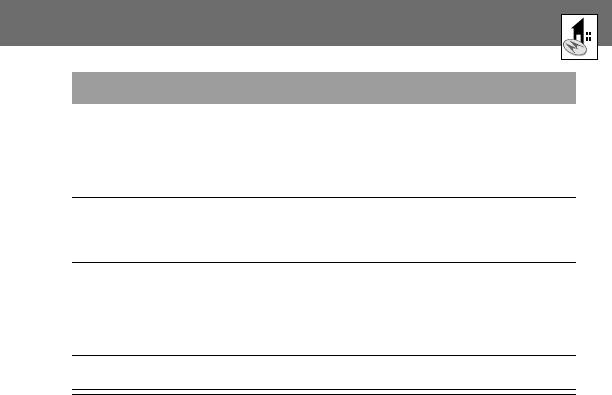
103
Shortcuts
Creating a Voice Shortcut
A voice shortcut lets you go directly to a menu item by
saying its shortcut name.
Your phone can store a total of four minutes of voice
recordings (including voice notes, voice names, and voice
shortcuts). Each voice shortcut uses two seconds of
recording time.
4
Press
CHANGE (+).
The Key entry blank appears
(your phone automatically
displays the next available key).
5
Press keypad keys
(optional).
The phone assigns a new key
for the shortcut
6
Press OK (+). The phone saves the key
shortcut and returns to the
shortcut options.
7
Press DONE (-). The shortcut options close.
Find the Feature
M>
the item to which you
want to assign a
shortcut
Do This Result

Shortcuts
104
Do This Result
1
Press and hold
M.
The phone displays:
Assign Shortcut for:
“
Item
”?
where
Item
is the name of the
item you selected.
2
Press YES (-). The shortcut options appear.
3
Press S. Scroll to Voice.
4
Press
RECORD (+).
The phone displays Press
Voice key then say voice
shortcut.
5
Press the voice key. The phone displays Say
Shortcut Now.
6
Say the shortcut
name.
The phone displays Press
Voice key then REPEAT voice
shortcut.
7
Press the voice key. The phone displays Repeat
Shortcut.
8
Repeat the shortcut
name.
The phone displays Trained:
Voice Shortcut and returns to
the shortcut options.
9
Press DONE (-). The shortcut options close.

105
Shortcuts
Using Shortcuts
You can use a shortcut any time, whether you are on a call
or scrolling through a menu.
Use a Keypad Shortcut
If you know the shortcut number:
Select a Shortcut From the List
To select a shortcut from the shortcut list:
Use a Voice Shortcut
To use a voice shortcut:
Press To
1
M open the menu
2
the shortcut’s
number
go to the menu item
Find the Feature
M> Shortcuts >
the
shortcut you want to use
Press To
1
M open the menu

Shortcuts
106
2
voice key and speak the
shortcut name into the
phone
go to the menu item
Press To

107
Voice Notes
The voice notes feature lets you record personal messages
or phone calls. You can play back a voice note at any time.
There are no pre-recorded voice notes on your phone.
Recording a Voice Note
Your phone can store a total of four minutes of voice
recordings (including voice notes, voice names, and voice
shortcuts).
Use this procedure to record a voice note when your
phone is inactive, or use it during a phone call to record
the call:
Do This Result
1
Press the voice key and
hold for one second.
Note: The voice key is
located on the right side
of your phone.
A tone sounds in the
earpiece and the phone
displays the Recording
VoiceNote message.
2
Release the voice key and
speak your voice message
into the phone.
The phone records the
message and displays a
recording timer.

Voice Notes
108
Viewing the Voice Notes List
The voice notes list shows all your voice notes along with
other important information and features.
New VoiceNote appears at the end of the list or by itself if
no voice notes are stored. Select New VoiceNote to view
instructions on how to record a new voice note.
3
Press the voice key again
to stop recording.
The phone displays the
voice notes list number
and the total recording
time.
Find the Feature
M> VoiceNotes
Do This Result
VoiceNotes
2:20pm 02/03
4:05pm 02/03
EXIT PLAY
f
Display voice notes
sub-menu
Play the
highlighted
voice note
Return to
previous screen
Scroll
through list
Locked
voice note
Time/date
recorded
M

109
Voice Notes
Playing a Voice Note
To play a recorded voice note:
Tip: You can play a voice note while taking a call. It won’t
be transmitted to the other party.
Playback Screen
While the voice note is playing, the playback screen is
displayed.
Find the Feature
M> VoiceNotes
Press To
1
S highlight voice note for playback
2
PLAY (+) play a voice note
Display voice notes
sub-menu
Erase
voice note
Return to
previous screen
Voice note
number
Press
#
to
fast forward
Press
*
to rewind
VoiceNote 3
{}
SAVE DELETE
Indicates
% played
M
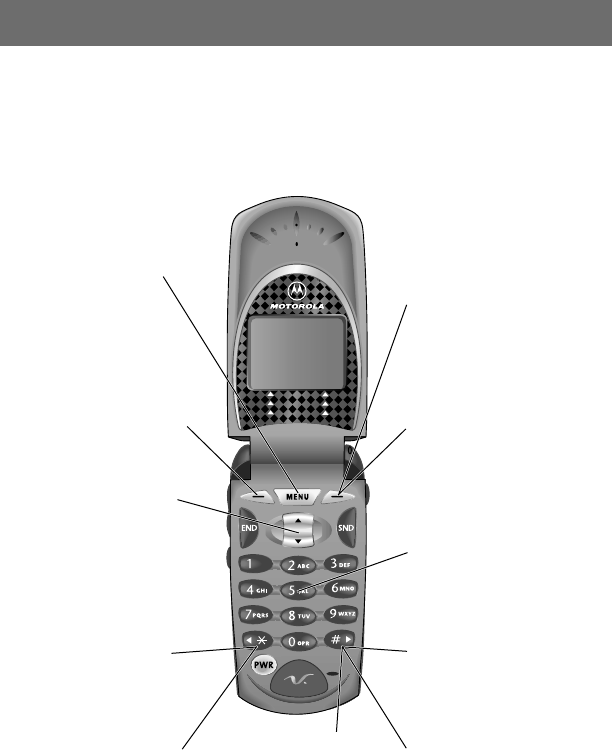
Voice Notes
110
Voice Note Keys
While playing back a voice note, press these keys to do
the following:
Stop playback
and return to
voice notes list.
Stop playback
and go to voice
notes menu.
Stop playback
and scroll up/
down to next
voice note.
Rewind three
seconds, resume
playing.
Press and hold
to rewind to the
beginning.
When playback is
complete, press to
restart.
Fast forward
three seconds,
resume playing.
Press number
keys to
alternately stop
and start
playback.
If the voice note
is locked, stop
playback and
unlock voice note.
Press and hold
to fast forward
to end.
If the voice note
is unlocked, stop
playback and
display
Delete
VoiceNote?

111
Voice Notes
Locking and Unlocking a Voice Note
You can prevent a voice note from being accidentally
deleted by locking it. To delete a locked voice note, you
must first unlock it.
You can also lock or unlock a voice note while playing it
back. When the playback screen is displayed:
Find the Feature
M> VoiceNotes
Press To
1
S scroll to the voice note you want
to lock or unlock
2
M open the voice notes menu
3
S scroll to Lock or Unlock
4
SELECT (+) lock or unlock the voice note
Press To
1
M open the voice notes menu
2
S scroll to Lock or Unlock
3
SELECT (+) lock or unlock the voice note

Voice Notes
112
Deleting a Voice Note
You can delete a single unlocked voice note or all
unlocked voice notes. To delete a locked voice note, you
must first unlock it. See “Locking and Unlocking a Voice
Note” on page 111.
Note: You can always press NO (+) to cancel a
deletion.
Find the Feature
M> VoiceNotes
Press To
1
S scroll to the voice note you want
to delete
2
M go to the voice notes menu
3
S scroll to Delete or Delete All
4
SELECT (+) select the highlighted option
The phone displays
Delete VoiceNote X?, or
Delete All VoiceNotes?
5
YES (-) delete the selected voice note, or
delete all unlocked voice notes

113
Browser
The browser lets you access Web pages and
Web-based applications on your phone. Contact
your service provider to set up access, if necessary.
Starting a Browser Session
To open the browser:
The browser displays your home page.
You can perform the following operations during a
browser session:
Find the Feature
M> Browser
Press To
1
S scroll to a bookmark, browser
service, or browser application
2
SELECT (+) select the service
Do This To
Press S to scroll to a
phone number on a Web
page, then press N
call the number from the
browser
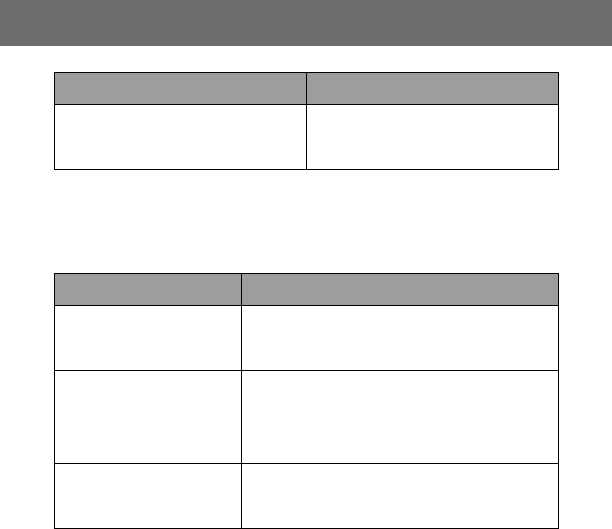
Browser
114
You may not be able to connect to a specific browser
service. Following are some common error messages:
Contact your service provider if you are unable to
establish a network connection with the browser.
Home Page Setup
Your default home page is either mymotorola.com or a
customized home page from your service provider. If
mymotorola.com is not your default home page, it is
stored in your phone as an additional Web address.
Press * and #go back and forward
between Web pages
Message Meaning
Browser not
available Your phone is unable to make a
network connection.
Home Page
not available The browser server is busy, or the
home page Web address stored in
your phone is incorrect.
Home Page
not setup A home page Web address is not
stored in your phone.
Do This To

115
Adjusting Your Settings
You can adjust a wide variety of phone settings to suit
your needs.
Ring/Vibrate
Your phone alerts you by ringing or vibrating when you
have incoming calls or other events. See “Display” on
page 27 for a list of the alert icons that can appear on the
display.
Select a Ring/Vibration for All Events
Select a Ring/Vibration for a Specific Event
When you select a ring/vibration alert for a
specific
event,
it overrides the alert type set for
all
events.
Find the Feature
M> Settings
> Ring/Vibrate > Alert
Press To
1
S scroll to an alert type
2
SELECT (+) select the alert type
The phone displays the Changed:
Alert message.

Adjusting Your Settings
116
Tip: This feature also lets you set the ringer volume and
keypad volume.
Find the Feature
M> Settings
> Ring/Vibrate
>
Alert
Detail
Press To
1
S scroll to the type of event that
should have a special alert
2
CHANGE (+) select the event
The phone displays the list of alert
types.
3
S scroll to the alert you want for the
event
4
SELECT (+) select the alert
The phone displays the Changed:
Event Alert
message.

117
Adjusting Your Settings
Reordering Menu Items
You can customize the order of the items in your phone’s
main menu, depending upon your usage.
Find the Feature
M> Settings
> Other Settings
> Personalize
> Main Menu
Press To
1
S scroll to the menu item you want
to move
2
GRAB (+) grab the menu item you want to
move
3
S move the item up or down the
menu
4
INSERT (+) insert the item in the new location

Adjusting Your Settings
118
Customizing a Soft Key Function
When your phone is idle, you can relabel the soft keys
(- and +) and smart key to access different items in
the main menu.
Hands-Free Use
The hands-free car kit is a Motorola accessory that
you can optionally purchase and install in your car.
The headset is another optional Motorola
accessory that provides an alternative way for you to use
your phone without using your hands.
Find the Feature
M> Settings
> Other Settings
> Personalize > Keys
Press To
1
S scroll to Left, Right, or Smart
2
CHANGE (+) open the key editor
3
S scroll to the new key function
4
CHANGE (+) confirm the new function
The key will have the new function
whenever the phone is idle.

119
Adjusting Your Settings
Automatic Answer
If you activate automatic answer and connect your phone
to a car kit or headset, your phone can automatically
answer calls after two rings.
Automatic Hands-Free
You can set up your phone to automatically transfers calls
when it detects that it is connected to a car kit or headset.
Find the Feature
M> Settings
> Other Settings
> Car Settings
> Auto Answer
Press To
1
S scroll to On or Off
2
SELECT (+) confirm the setting
Find the Feature
M> Settings
> Other Settings
> Car Settings
> Auto Handsfree
Press To
1
S scroll to On or Off
2
SELECT (+) confirm the setting

Adjusting Your Settings
120
Power-Off Delay
When your phone is connected to a car kit or headset, you
can set it to stay on for a specified time period after you
switch off the ignition. This keeps your phone from
draining your car battery by staying on indefinitely, but
leaves your phone on long enough that you do not have
to re-enter your unlock code when you make short stops.
Caution: If you select Continuous, the phone does not
power off when you turn off the ignition. Be careful not to
accidentally drain your car battery if you select this option.
Find the Feature
M> Settings
> Other Settings
> Car Settings
> Power-Off Delay
Press To
1
S scroll to the time delay option you
want
2
SELECT (+) confirm your selection

121
Data and Fax Calls
You can use a Motorola Original data kit to
transfer data from your phone to a compatible
computer. By transferring data, you can:
• synchronize data between your phone and computer
or TrueSync® software. Contact Motorola customer
service for information on obtaining accessory
products.
• use your phone as a modem to connect to the
Internet
• use your phone to send fax calls from your computer
More information about Motorola Original data kits is
available at
http://www.motorola.com/dataaccessories
Connecting Your Phone to an External
Device
Connect your phone to an external device using a serial
cable or USB cable, or a cable and a PCMCIA card.Attach
a Motorola approved USB or serial cable to the computer
and the phone as follows.

Data and Fax Calls
122
Set Up a Cable Connection
Note: To conserve power, some laptops deactivate
unused serial ports. If this happens, open an application
that uses the serial port, like fax or dial-up networking,
and your computer will automatically activate the port.
USB Cable
To attach the USB cable:
Do This
1
Plug the end with the
Motorola logo into the
base of your phone, with
both the face of the
phone and the logo facing
you.
2
Plug the other end, the
USB connection, into the
appropriate USB slot on
your PC.
Illustration to
come
Illustration to
come

123
Data and Fax Calls
Serial Cable
You can use the interchangeable head on the Multi-
Connect Serial Cable to connect PC, Palm III, or Palm V
devices to your phone.
Do This
1
Plug the serial cable into
the detachable head, as
shown.
2
Insert the end of the cable
with the AMP logo into
the bottom connector of
the cable head (with the
logos on both the cable
and the head facing you)
3
With both logos and the
front of the phone facing
you, insert the cable head
into the base of the
phone.
Illustration to
come
Illustration to
come

Data and Fax Calls
124
Installing the Software
Install the software from the CD-ROM that came with
your data cable. Refer to the software’s user guide for
more detailed information.
Sending a Data or Fax Call
Important: You cannot dial data or fax numbers through
your phone’s keypad. You must dial them through your
computer.
4
Plug the other end into
the appropriate serial
interface connection on
the back of your computer
and tighten the screws by
hand.
Do This To
1
Check the
phone
make sure that the phone is
connected and powered on
2
Open the
application on
your computer
place the call through the
application (such as dial-up-
networking or fax)
Do This
Illustration to
come

125
Data and Fax Calls
Receiving a Data or Fax Call
Before you receive a data or fax call, you must configure
your phone for the incoming call type.
3
End the
transfer on
your computer
close the call and connection when
the transfer is complete
Find the Feature
M> Settings
> Connection
> Incoming Call
Press To
1
S scroll to Fax In Only,
Data In Only, or Normal
2
SELECT (+) specify the format for the next
incoming call
Do This To

Data and Fax Calls
126
Connect to the device that will receive the data or fax.
Your phone notifies you when the data or fax call arrives.
Press To
N answer the call (the phone transfers
the call to the fax machine or
computer)
When transfer is complete, end the
call from the connected machine.

127
Security
Assigning a New Code or Password
The four-digit unlock code is originally set to 1234, and
the six-digit security code is originally set to 000000. We
suggest you change these numbers and make a note of
them. The unlock code must contain four digits, and the
security code must contain six digits.
Note: If the only password you can change is the unlock
code, the New Passwords menu is unavailable and the
Unlock Code option appears on the Phone Lock menu. In
this case, open the unlock code editor by selecting: M
> Settings > Security > Phone Lock > Unlock Code.
Find the Feature
M> Settings > Security
> New Passwords*
Press To
1
S scroll to the code or password you
want to change
2
CHANGE (+) select the code or password
3
keypad keys enter your old code
If you do not know your code, see
“If You Forget a Code or
Password” on page 128.

Security
128
If You Forget a Code or Password
If you forget your security code (originally set to 000000),
contact your service provider.
If you forget your unlock code, try entering 1234 or the
last four digits of your phone number. If that does not
work, do the following when you see the
Enter Unlock Code message:
4
OK (+) submit your old code
5
keypad keys enter the new code
6
OK (+) assign the new code
7
keypad keys re-enter the new code
8
OK (+) confirm the new code
Press To
1
M go to the security code option
2
keypad keys enter your security code
3
OK (+) submit your security code
Press To

129
Security
Locking and Unlocking Your Phone
You can lock your phone manually or set your phone to
lock automatically whenever you turn it off.
When you try to use a locked phone, it asks you to enter
the unlock code. A locked phone still rings or vibrates for
incoming calls or messages, but you must unlock it to
answer.
Lock Your Phone Manually
Set Your Phone to Lock Automatically
You can set your phone to lock every time you turn it off:
Find the Feature
M> Settings > Security
> Phone Lock
> Lock Now
Press To
1
keypad keys enter your four-digit unlock code
2
OK (+) lock the phone
Find the Feature
M> Settings > Security
> Phone Lock
> Automatic Lock > On

Security
130
Unlock Your Phone
At the Enter Unlock Code prompt:
Locking and Unlocking Your Keypad
Note: Incoming calls and messages unlock the keypad.
Press To
1
keypad keys enter your four-digit unlock code
2
OK (+) set the phone to lock
automatically
Press To
1
keypad keys enter your four-digit unlock code
The unlock code is originally set to
1234. If necessary, see “If You
Forget a Code or Password” on
page 128.
2
OK (+) unlock the phone
Press To
M *lock or unlock your keypad

131
Security
Restricting Calls
You can stop all outgoing or incoming calls, or you can
restrict them to the numbers stored in your phonebook.
Notes:
• You can still place calls to emergency numbers when
outgoing calls are restricted.
• Your phone still receives incoming text messages
when incoming calls are restricted.
Find the Feature
M> Settings > Security
> Restrict Calls
Press To
1
keypad keys enter your unlock code (four digits
maximum)
2
OK (+) open the restricting calls menu
3
S scroll to Outgoing Calls or
Incoming Calls
4
CHANGE (+) select Outgoing Calls or Incoming
Calls
5
S scroll to Allow
6
CHANGE (+) change Allow

Security
132
7
S scroll to the calls you want to
allow
8
SELECT (+) select the calls you want to allow
Press To

133
Troubleshooting
Check these questions first if you have problems with your
phone:
Question Answer
Is your phone
set up
correctly?
Press M #. If you do not see
your phone number, contact your
service provider.
Is your battery
charged? Do
you see B in
the display?
The battery level indicator should
have at least one segment showing
(C). If it does not, recharge your
battery. (See “Charging the
Battery” on page 23 and “Battery
Use” on page 34.)
Does the
handset have a
signal? Do you
see j in the
display?
Make sure that your antenna is fully
extended. The signal strength
indicator should have at least one
segment showing (1). If it does
not, move to an area with a
stronger signal to use your phone.
Is the earpiece
volume too
low?
While on a call, press the upper
volume key on the side of your
phone.

Troubleshooting
134
The following refer to specific problems:
Is the other
party unable to
hear you?
Make sure that your antenna is fully
extended and that your phone is
not muted. Press UNMUTE (+) if
necessary to unmute the phone.
Has the phone
been damaged,
dropped, or
gotten wet?
Dropping your phone, getting it
wet, or using a non-Motorola
battery or battery charger can
damage the phone. The phone
warranty does not cover liquid
damage or damage caused from
using non-Motorola accessories.
Was a
non-Motorola
battery or
battery charger
used?
Problem Solution
My phone was
stolen. To whom
should I report
this?
Report a stolen phone to the police
and to your service provider (the
company that sends you your
monthly wireless service bill).
I forgot my
password. What
should I do?
See “If You Forget a Code or
Password” on page 128.
Question Answer

135
Troubleshooting
I pressed the
power key, but
nothing
happened.
Be sure to press and hold P until
the display appears and you hear
an audible alert (this could take a
couple of seconds). If nothing
happens, check that a charged
battery is installed. (See “Installing
the Battery” on page 21.)
The display
says: Enter
Unlock Code.
How do I unlock
my phone?
Enter the factory-preset unlock
code (1234), or the last four digits
of your phone number. (See
“Locking and Unlocking Your
Phone” on page 129.) If this fails,
call your service provider (the
company that sends you your
monthly wireless service bill).
Why does my
phone ask for
an unlock code
when I try to
open a feature?
The application you want is locked.
If you own the phone but do not
know the unlock code, see “If You
Forget a Code or Password” on
page 128.
My phone does
not ring. If you see t, y, or u in the
display, then the ringer is turned
off. See “Ring/Vibrate” on
page 115.
Problem Solution

Troubleshooting
136
I tried to place a
call and heard
an alternating
high/low tone.
Your call did not reach the wireless
system. You may have dialed the
number too soon after turning the
phone on. Wait until the display
says Ready before making a call.
I cannot send/
receive calls. Make sure that your antenna is fully
extended and that you have a
phone signal (see the information
about your signal strength indicator
on page 28). Avoid electrical or
radio interference, and obstructions
such as bridges, parking garages, or
tall buildings.
Your phone also may have restrict
calls turned on. If you know the
unlock code, you can change this
setting in the Security menu
(M > Settings > Security).
Problem Solution

137
Troubleshooting
My phone has
poor reception
and drops calls.
Make sure that your antenna is fully
extended and is not bent or
damaged.
Also, make sure you have a phone
signal. (See the information about
your signal strength indicator on
page 28.) Stay clear of any
obstructions such as bridges,
parking garages, or tall buildings.
I cannot hear
others on my
phone.
While on a call, press the upper
volume key on the left side of your
phone. Your phone display should
show the volume increasing.
Also, make sure that your phone’s
earpiece is not blocked by its
carrying case.
Others cannot
hear me when I
talk on my
phone.
If Mute appears in your display
during a call, press UNMUTE (+).
Also, make sure that your phone’s
microphone is not blocked by its
carrying case or a sticker.
Problem Solution

Troubleshooting
138
I cannot open
my inbox. Before you can use text or
information services messages, you
must set up the appropriate inbox.
See “Setting Up the Text Message
Inbox” on page 94.
How do I see
the calls I sent
or received?
To see the last 10 calls you dialed
or received, open the “Recent
Calls” lists:
M> Recent Calls
> Dialed Calls or
> Received Calls
My phone will
not send
voicemail
commands,
passwords, or
other codes.
Your phone sends commands and
passwords as DTMF tones. You can
set your phone’s DTMF tones to be
On or Off. If you have trouble
sending numbers, try changing your
DTMF setting.
1
From the idle display, press:
M> Settings
> Other Settings
> Initial Setup > DTMF
2
Press S to scroll to On.
3
Press SELECT (+) to select it.
Problem Solution

139
Troubleshooting
My phone’s
display is too
dark.
You can use the Contrast Setting
feature (see page 61) to change the
level of contrast in your phone
display.
You can also use the Backlight
Display feature (see page 61) to
change the length of time that your
phone’s backlight display stays on.
My battery
didn’t last as
long as I
expected. What
can I do to
extend battery
life?
Your battery’s performance is
affected by charge time, feature
use, temperature changes, and
other factors. For tips on extending
your battery life, see “Charging the
Battery” on page 23.
Problem Solution

Troubleshooting
140
I plugged the
data cable into
my phone but
my phone did
not beep. How
do I know if the
data cable is
ready to go?
The beep indicates that you are set
up correctly. If you did not hear a
beep, make sure that both ends of
the data cable are connected—the
smaller end to your phone and the
larger end to your computer.
Finally, your computer may have
deactivated the port to save power.
Try opening an application that
uses the port, like a fax or dial-up
application, and your computer will
automatically activate the port.
Problem Solution

141
Troubleshooting
My phone
beeped when I
attached the
data cable, but
my fax and data
applications
don’t work.
You must be in an area with digital
coverage. Check your phone’s
display for the digital signal
indicator (F).
Some wireless networks may not
support data or fax transmission. If
you see the digital indicator, but
you are roaming on an unfamiliar
network, this may be the case.
Also, remember that data and fax
transmission usually requires a
subscription. Call your service
provider for more information.
When sending
data with the
data cable, why
does the
computer show
a connection
rate of 19200
Kbps?
19200 Kbps is the data transfer
rate of the connection between
your computer and the phone. The
rate of the connection between
your phone and the network is
displayed on your phone, and will
be either 14400 or 9600 Kbps.
Problem Solution

Troubleshooting
142
I can’t end my
data call by
closing the
application on
my computer.
What can I do?
Try pressing N on your phone. Also
try disconnecting the cable or
turning off the phone. If possible,
always close the connection
through your computer. These
alternative methods may disrupt
the application on your computer.
I launched the
Browser but the
display says:
Service Not
Available.
You may be in an area without
service. If you have wireless service,
look in the display for the digital
signal indicator (F). If you do not
see the indicator, you may be in an
area that has only analog service or
no service at all. If you see the
digital signal indicator, you may be
connected to a digital network that
does not support Internet access.
I launched the
Browser but the
display says:
Data Server
Unavailable.
Try again in a few minutes. The
servers may be temporarily busy.
Problem Solution
143
Specific Absorption Rate Data
This model phone meets the government’s
requirements for exposure to radio waves.
Your wireless phone is a radio transmitter and receiver. It
is designed and manufactured not to exceed the emission
limits for exposure to radio frequency (RF) energy set by
the Federal Communications Commission of the U.S.
Government. These limits are part of comprehensive
guidelines and establish permitted levels of RF energy for
the general population. The guidelines are based on
standards that were developed by independent scientific
organizations through periodic and thorough evaluation
of scientific studies. The standards include a substantial
safety margin designed to assure the safety of all persons,
regardless of age and health.
The exposure standard for wireless mobile phones
employs a unit of measurement known as the Specific
Absorption Rate, or SAR. The SAR limit set by the FCC is
1.6W/kg.* Tests for SAR are conducted using standard
operating positions specified by the FCC with the phone
transmitting at its highest certified power level in all
tested frequency bands. Although the SAR is determined
at the highest certified power level, the actual SAR level of
the phone while operating can be well below the
maximum value. This is because the phone is designed to
operate at multiple power levels so as to use only the
144
power required to reach the network. In general, the
closer you are to a wireless base station antenna, the
lower the power output.
Before a phone model is available for sale to the public, it
must be tested and certified to the FCC that it does not
exceed the limit established by the government-adopted
requirement for safe exposure. The tests are performed in
positions and locations (e.g., at the ear and worn on the
body) as required by the FCC for each model. The highest
SAR value for this model phone when tested for use at the
ear is ____ and when worn on the body, as described in
this user guide, is ____. (Body-worn measurements differ
among phone models, depending upon available
accessories and FCC requirements). While there may be
differences between the SAR levels of various phones and
at various positions, they all meet the government
requirement.
The FCC has granted an Equipment Authorization for this
model phone with all reported SAR levels evaluated as in
compliance with the FCC RF emission guidelines. SAR
information on this model phone is on file with the FCC
and can be found under the Display Grant section of
http://www.fcc.gov/oet/fccid
after searching on FCC ID XXXX.
* In the United States and Canada, the SAR limit for
mobile phones used by the public is 1.6 watts/kg (W/kg)
averaged over one gram of tissue. The standard
145
incorporates a substantial margin of safety to give
additional protection for the public and to account for any
variations in measurements.

146
The U.S. Food and Drug
Administration's Center for Devices
and Radiological Health Consumer Update on
Mobile Phones
FDA Update
FDA has been receiving inquiries about the safety of
mobile phones, including cellular phones and PCS phones.
The following summarizes what is known—and what
remains unknown—about whether these products can
pose a hazard to health, and what can be done to
minimize any potential risk. This information may be used
to respond to questions.
Why the concern?
Mobile phones emit low levels of radio frequency energy
(i.e., radio frequency radiation) in the microwave range
while being used. They also emit very low levels of radio
frequency energy (RF), considered non-significant, when
in the stand-by mode. It is well known that high levels of
RF can produce biological damage through heating
effects (this is how your microwave oven is able to cook
food). However, it is not known whether, to what extent,
or through what mechanism, lower levels of RF might
cause adverse health effects as well. Although some
research has been done to address these questions, no
clear picture of the biological effects of this type of
radiation has emerged to date. Thus, the available science
147
does not allow us to conclude that mobile phones are
absolutely safe, or that they are unsafe. However, the
available scientific evidence does not demonstrate any
adverse health effects associated with the use of mobile
phones.
What kinds of phones are in question?
Questions have been raised about hand-held mobile
phones, the kind that have a built-in antenna that is
positioned close to the user's head during normal
telephone conversation. These types of mobile phones are
of concern because of the short distance between the
phone's antenna—the primary source of the RF—and the
person's head. The exposure to RF from mobile phones in
which the antenna is located at greater distances from the
user (on the outside of a car, for example) is drastically
lower than that from hand-held phones, because a
person's RF exposure decreases rapidly with distance from
the source. The safety of so-called “cordless phones,”
which have a base unit connected to the telephone wiring
in a house and which operate at far lower power levels
and frequencies, has not been questioned.
How much evidence is there that hand-held mobile
phones might be harmful?
Briefly, there is not enough evidence to know for sure,
either way; however, research efforts are on-going. The
existing scientific evidence is conflicting and many of the
148
studies that have been done to date have suffered from
flaws in their research methods. Animal experiments
investigating the effects of RF exposures characteristic of
mobile phones have yielded conflicting results. A few
animal studies, however, have suggested that low levels
of RF could accelerate the development of cancer in
laboratory animals. In one study, mice genetically altered
to be predisposed to developing one type of cancer
developed more than twice as many such cancers when
they were exposed to RF energy compared to controls.
There is much uncertainty among scientists about whether
results obtained from animal studies apply to the use of
mobile phones. First, it is uncertain how to apply the
results obtained in rats and mice to humans. Second,
many of the studies that showed increased tumor
development used animals that had already been treated
with cancer-causing chemicals, and other studies exposed
the animals to the RF virtually continuously—up to 22
hours per day.
For the past five years in the United States, the mobile
phone industry has supported research into the safety of
mobile phones. This research has resulted in two findings
in particular that merit additional study:
1
In a hospital-based, case-control study, researchers
looked for an association between mobile phone use
and either glioma (a type of brain cancer) or acoustic
neuroma (a benign tumor of the nerve sheath). No
149
statistically significant association was found between
mobile phone use and acoustic neuroma. There was
also no association between mobile phone use and
gliomas when all types of types of gliomas were
considered together. It should be noted that the
average length of mobile phone exposure in this
study was less than three years.
When 20 types of glioma were considered separately,
however, an association was found between mobile
phone use and one rare type of glioma,
neuroepithelliomatous tumors. It is possible with
multiple comparisons of the same sample that this
association occurred by chance. Moreover, the risk did
not increase with how often the mobile phone was
used, or the length of the calls. In fact, the risk
actually decreased with cumulative hours of mobile
phone use. Most cancer causing agents increase risk
with increased exposure. An ongoing study of brain
cancers by the National Cancer Institute is expected
to bear on the accuracy and repeatability of these
results.1
2
Researchers conducted a large battery of laboratory
tests to assess the effects of exposure to mobile
phone RF on genetic material. These included tests for
several kinds of abnormalities, including mutations,
chromosomal aberrations, DNA strand breaks, and
structural changes in the genetic material of blood
150
cells called lymphocytes. None of the tests showed
any effect of the RF except for the micronucleus assay,
which detects structural effects on the genetic
material. The cells in this assay showed changes after
exposure to simulated cell phone radiation, but only
after 24 hours of exposure. It is possible that exposing
the test cells to radiation for this long resulted in
heating. Since this assay is known to be sensitive to
heating, heat alone could have caused the
abnormalities to occur. The data already in the
literature on the response of the micronucleus assay
to RF are conflicting. Thus, follow-up research is
necessary.2
FDA is currently working with government, industry, and
academic groups to ensure the proper follow-up to these
industry-funded research findings. Collaboration with the
Cellular Telecommunications Industry Association (CTIA)
in particular is expected to lead to FDA providing research
recommendations and scientific oversight of new CTIA-
funded research based on such recommendations.
Two other studies of interest have been reported recently
in the literature:
1
Two groups of 18 people were exposed to simulated
mobile phone signals under laboratory conditions
while they performed cognitive function tests. There
were no changes in the subjects' ability to recall
words, numbers, or pictures, or in their spatial
151
memory, but they were able to make choices more
quickly in one visual test when they were exposed to
simulated mobile phone signals. This was the only
change noted among more than 20 variables
compared.3
2
In a study of 209 brain tumor cases and 425 matched
controls, there was no increased risk of brain tumors
associated with mobile phone use. When tumors did
exist in certain locations, however, they were more
likely to be on the side of the head where the mobile
phone was used.
Because this occurred in only a small number of
cases, the increased likelihood was too small to be
statistically significant.4
In summary, we do not have enough information at this
point to assure the public that there are, or are not, any
low incident health problems associated with use of
mobile phones. FDA continues to work with all parties,
including other federal agencies and industry, to assure
that research is undertaken to provide the necessary
answers to the outstanding questions about the safety of
mobile phones.
152
What is known about cases of human cancer that
have been reported in users of hand-held mobile
phones?
Some people who have used mobile phones have been
diagnosed with brain cancer. But it is important to
understand that this type of cancer also occurs among
people who have not used mobile phones. In fact, brain
cancer occurs in the U.S. population at a rate of about 6
new cases per 100,000 people each year. At that rate,
assuming 80 million users of mobile phones (a number
increasing at a rate of about 1 million per month), about
4800 cases of brain cancer would be expected each year
among those 80 million people, whether or not they used
their phones. Thus it is not possible to tell whether any
individual's cancer arose because of the phone, or
whether it would have happened anyway. A key question
is whether the risk of getting a particular form of cancer is
greater among people who use mobile phones than
among the rest of the population. One way to answer that
question is to compare the usage of mobile phones
among people with brain cancer with the use of mobile
phones among appropriately matched people without
brain cancer. This is called a case-control study. The
current case-control study of brain cancers by the National
Cancer Institute, as well as the follow-up research to be
sponsored by industry, will begin to generate this type of
information.
153
What is FDA's role concerning the safety of mobile
phones?
Under the law, FDA does not review the safety of
radiation-emitting consumer products such as mobile
phones before marketing, as it does with new drugs or
medical devices. However, the agency has authority to
take action if mobile phones are shown to emit radiation
at a level that is hazardous to the user. In such a case,
FDA could require the manufacturers of mobile phones to
notify users of the health hazard and to repair, replace or
recall the phones so that the hazard no longer exists.
Although the existing scientific data do not justify FDA
regulatory actions at this time, FDA has urged the mobile
phone industry to take a number of steps to assure public
safety. The agency has recommended that the industry:
• support needed research into possible biological
effects of RF of the type emitted by mobile phones
• design mobile phones in a way that minimizes any RF
exposure to the user that is not necessary for device
function
• cooperate in providing mobile phone users with the
best possible information on what is known about
possible effects of mobile phone use on human health
At the same time, FDA belongs to an interagency working
group of the federal agencies that have responsibility for
154
different aspects of mobile phone safety to ensure a
coordinated effort at the federal level. These agencies are:
• National Institute for Occupational Safety and Health
• Environmental Protection Agency
• Federal Communications Commission
• Occupational Health and Safety Administration
• National Telecommunications and Information
Administration
The National Institutes of Health also participates in this
group.
In the absence of conclusive information about any
possible risk, what can concerned individuals do?
If there is a risk from these products—and at this point
we do not know that there is—it is probably very small.
But if people are concerned about avoiding even potential
risks, there are simple steps they can take to do so. For
example, time is a key factor in how much exposure a
person receives. Those persons who spend long periods of
time on their hand-held mobile phones could consider
holding lengthy conversations on conventional phones
and reserving the hand-held models for shorter
conversations or for situations when other types of
phones are not available.
155
People who must conduct extended conversations in their
cars every day could switch to a type of mobile phone that
places more distance between their bodies and the source
of the RF, since the exposure level drops off dramatically
with distance. For example, they could switch to:
• a mobile phone in which the antenna is located
outside the vehicle
• a hand-held phone with a built-in antenna connected
to a different antenna mounted on the outside of the
car or built into a separate package
• a headset with a remote antenna to a mobile phone
carried at the waist
Again, the scientific data do not demonstrate that mobile
phones are harmful. But if people are concerned about
the radio frequency energy from these products, taking
the simple precautions outlined above can reduce any
possible risk.
Where can I find additional information?
For additional information, see the following Web sites:
Federal Communications Commission (FCC) RF
Safety Program (select “Information on Human Exposure
to RF Fields from Cellular and PCS Radio Transmitters”):
http://www.fcc.gov/oet/rfsafety
156
World Health Organization (WHO) International
Commission on Non-Ionizing Radiation Protection
(select Qs & As):
http://www.who.int/emf
United Kingdom, National Radiological Protection
Board:
http://www.nrpb.org.uk
Cellular Telecommunications Industry Association
(CTIA):
http://www.wow-com.com
U.S. Food and Drug Administration (FDA) Center for
Devices and Radiological Health:
http://www.fda.gov/cdrh/consumer/
1. Muscat et al. Epidemiological Study of Cellular Telephone Use and
Malignant Brain Tumors. In: State of the Science Symposium;1999
June 20; Long Beach, California.
2. Tice et al. Tests of mobile phone signals for activity in genotoxicity
and other laboratory assays. In: Annual Meeting of the
Environmental Mutagen Society; March 29, 1999, Washington,
D.C.; and personal communication, unpublished results.
3. Preece, AW, Iwi, G, Davies-Smith, A, Wesnes, K, Butler, S, Lim, E,
and Varey, A. Effect of a 915-MHz simulated mobile phone signal
on cognitive function in man. Int. J. Radiat. Biol., April 8, 1999.
4. Hardell, L, Nasman, A, Pahlson, A, Hallquist, A and Mild, KH. Use
of cellular telephones and the risk for brain tumors: a case-control
study. Int. J. Oncol., 15: 113-116, 1999.
FDA020400
157
Export Law Assurances
This product is controlled under the export regulations of
the United States of America and Canada. The
Governments of the United States of America and Canada
may restrict the exportation or re-exportation of this
product to certain destinations. For further information
contact the U.S. Department of Commerce or the
Canadian Department of Foreign Affairs and International
Trade.
158
Patent Information
Manufactured under one or more of the following U.S.
patents:
4291475
4302845
4312074
4365221
4369516
4369520
4369522
4374370
4378603
4390963
4398265
4400584
4400585
4434461
4455534
4486624
4491972
4523155
4546329
4574243
4581602
4581749
4585957
4593155
4594657
4602218
4605987
4616314
4617520
4628529
4629829
4633141
4636593
4636741
4648125
4649543
4654655
4680787
4704588
4711361
4715063
4717884
4730195
4731813
4736277
4737976
4741018
4742562
4761621
4764737
4775998
4791527
4794489
4797929
4797947
4798975
4802236
4803726
4809356
4811377
4811404
4817157
4827507
4829543
4831647
4843621
4845772
4851966
4852090
4860336
4860341
4868576
4870686
4872196
4873683
4876552
4876656
4876740
4879533
4885553
4887050
4890199
4896124
4896361
4897873
4903326
4903327
4904549
4904992
4905288
4905301
4912602
4916262
4918431
4918732
4922178
4941203
4942570
4945570
4956854
4959851
4963812
4964121
4970475
4972355
4972432
4972455
4975808
4977589
4977616
4979207
4984219
4984290
4989230
4992753
4996529
5008925
5010309
5010570
5014294
5014346
5017856
5018188
5020076
5020091
5020092
5020093
5023580
5023866
5023911
5025387
5027388
5028083
5028859
5029233
5036532
5038253
5040127
159
5042071
5045824
5053924
5055800
5055802
5055803
5057762
5058136
5059885
5060264
5063340
5065408
5067139
5070310
5077757
5077790
5081674
5083304
5087004
5093632
5095503
5107487
5109400
5111162
5113400
5113436
5117073
5117441
5117449
5117450
5121047
5121288
5121412
5122480
5122722
5124889
5127040
5127042
5127100
5128834
5133010
5134717
5140286
5140635
5142551
5142696
5144533
5146620
5148471
5148473
5150075
5150359
5150384
5151643
5152006
5152007
5153590
5157693
5160898
5162144
5163159
5164652
5166596
5166642
5168522
5170173
5170485
5170492
5175729
5175759
5175874
5182749
5185566
5185790
5187640
5187809
5192924
5193223
5195106
5195108
5198887
5200655
5201069
5203009
5203012
5203013
5203021
5204977
5205751
5210793
5211581
5212815
5212826
5214675
5214774
5216389
5220290
5220936
5222078
5222104
5222251
5230007
5230093
5233506
5233633
5235492
5237257
5237570
5239127
5241545
5241548
5241592
5241688
5242767
5243355
5247544
5247565
5249302
5251331
5255292
5257414
5259005
5260170
5260988
5261119
5262710
5263052
5263055
5265271
5267230
5276588
5276707
5276913
5276915
5278832
5278994
5280630
5280637
5280644
5285443
5287013
5287553
5287555
5287556
5289505
5297142
5299232
5301365
5308716
5321705
5321737
5321847
5323421
5325405
5325429
5327578
5327642
5331123
5333153
5336984
5338909
5343213
5349588
5351245
5359696
5361400
5363071
5365549
160
5366826
5367538
5367558
5371791
5373101
5375143
5375258
5379324
5381114
5384825
5392000
5392023
5392331
5396654
5401927
5402447
5402448
5404580
5404582
5406146
5406562
5408693
5410275
5410741
5414711
5420759
5424689
5428362
5428820
5428836
5430416
5432017
5434947
5436802
5438684
5442680
5444764
5446763
5446766
5448763
5448770
5448771
5453997
5457744
5459640
5459774
5461643
5463351
5463406
5463628
5463646
5463674
5463688
5463694
5465409
5465412
5469177
5471671
5475752
5477192
5485506
5485513
5486843
5487184
5488649
5490177
5491739
5493198
5493700
5493714
5495206
5495208
5497126
5497382
5497383
5499273
5499394
5499397
5502437
5504494
5504812
5506490
5508709
5509048
5510693
5511235
5513078
5513996
5519303
5519346
5519506
5519777
5524276
5526398
5528666
5530399
5530922
5533119
5535258
5535434
5539360
5542016
5542103
5542106
5542116
5544250
5546275
5546380
5551078
5551627
5553137
5553376
5554996
5555550
5557743
5559471
5559522
5559806
5561436
5561437
5561852
5565881
5566224
5568548
5570453
5572223
5572224
5574976
5577267
5577268
5583520
5584054
5586146
5588041
5589796
5590177
5594778
5594951
5598129
5598431
5600341
5604050
5604468
5604787
5606332
5606560
5606730
5613229
5613863
5615233
5615259
5615260
5621763
5621766
5625316
5625683
5628001
5628057
5628089
5629979
5630159
5630210
5630213
5630215
5631538
5633484
5633786
5634202
161
5640690
5642368
5646576
5649306
5649309
5656914
5656917
5657418
5659601
5660945
5661433
5664973
5666429
5668871
5670912
5673001
5673003
5673287
5674326
5675591
5675702
5678201
5678221
5678227
5680063
5684384
5691947
5692046
5692101
5696497
5696821
5699070
5699389
5699408
5701130
5701244
5701589
5703470
5703539
5703909
5706019
5706313
5708445
5710862
5710987
5711001
5715520
5715524
5717307
5722052
5724004
5726983
5729221
5732350
5737327
5737685
5738954
5739792
5740525
5742894
5745116
5745566
5745848
5747970
5748727
5754141
5754455
5754583
5754645
5754956
5758271
5760714
5761300
5761610
5764100
5764111
5764730
5764743
5766794
5771182
5771471
5777521
5777856
5784368
5784419
5784585
5787128
5787577
5793315
5793866
5796822
5797101
5798716
5799011
5799256
5801513
5801567
5802111
5805992
5807012
5808585
5808586
5809020
5809419
5809421
5809430
5809433
5809544
5812093
5812542
5812590
5814798
5815507
5815570
5815804
5815805
5815807
5815820
5821820
5822726
5826224
5831826
5832080
5832388
5835006
5835535
5835785
5838202
5841851
5842122
5844943
5846094
5848072
5848152
5848356
5848718
5850440
5854549
5854785
5854972
5856763
5856766
5857148
5857192
5859522
5859567
5859890
5861853
5862460
5862493
5864799
5865487
5867063
5867127
5867140
5867510
5870670
5872744
5877633
5878075
5878209
5878336
5878353
5880637
5880646
5881377
5889737
5889768
162
5889859
5892410
5893036
5894597
5896054
5896261
5898933
5900829
5901347
5901357
5903825
5903852
5905956
5907418
5907615
5909102
5910944
5912648
5920549
5920550
5923007
5924044
5925835
5925942
5926119
5926503
5926751
5930268
5930288
5930299
5933330
5936516
5936972
5939939
5940452
5940746
5943027
5945852
5945964
5946395
5949020
5950131
5950139
5953413
5954817
5955700
5955999
5956626
5963848
5963876
5964858
5966101
5966667
5966671
5969545
5974042
5977916
5980268
5982881
5983082
5987012
5988577
5995050
5996178
5999115
5999821
5999832
6002922
6002937
6005498
6006104
6008636
6009168
6009309
6009325
6009336
6009552
6011699
6011784
6011959
6011961
6012634
6014376
6014552
6016312
6016422
6018584
6018651
6018671
6021332
D284759
D285439
D288432
D288683
D289156
D292578
D292920
D295627
D295973
D295975
D296187
D297734
D297735
D297736
D299136
D299137
D299232
D300742
D300827
D301473
D301476
D301883
D302015
D303656
D304189
D305427
D305717
D306015
D306163
D306293
D306299
D306441
D306583
D306594
D307271
D309301
D309451
D314173
D315330
D315346
D315543
D315559
D315565
D315907
D316417
D316859
D320780
D322783
D324024
D324388
D325028
D325029
D325032
D325583
D325915
D327061
D327062
D328302
D332261
D332785
D334746
D337332
D338012
D338887
D339127
D339335
D339336
D339337
D339564
D339578
D339581
D339582
D340709
D340710
D340711
D340906
D341589
D342248
163
D342663
D342729
D342730
D342741
D343173
D343615
D343616
D343834
D343835
D343836
D344087
D344271
D344444
D344511
D344512
D344945
D345977
D346785
D346786
D346798
D348071
D348250
D348427
D348470
D348665
D348666
D348668
D348674
D348880
D349273
D349701
D350113
D350348
D350349
D350350
D351375
D351840
D352497
D352503
D352946
D353131
D353361
D353587
D353588
D353591
D354055
D354062
D355181
D355895
D356084
D356309
D357224
D357249
D357457
D357680
D357681
D358148
D359052
D359734
D359735
D359959
D360398
D360632
D361070
D361763
D362840
D362852
D365094
D365817
D366872
D367640
D368479
D368696
D369162
D369359
D369797
D370016
D370463
D370672
D372237
D372481
D372703
D372896
D372919
D373585
D373764
D374013
D374014
D374227
D374424
D374872
D375732
D375733
D375734
D375932
D375935
D375952
D376127
D377792
D377934
D378366
D378911
D379558
D379624
D379981
D379982
D380468
D380751
D381021
D381664
D382537
D382538
D382872
D383115
D383748
D383749
D383759
D384080
D384662
D384951
D384952
D385271
D385283
D385555
D385873
D385874
D385875
D385877
D385888
D386175
D386494
D386757
D387054
D387055
D387199
D387346
D388078
D388079
D388080
D388081
D388082
D388424
D388429
D388430
D388775
D388783
D388793
D389157
D389476
D389478
D389488
D389641
D390221
D390222
D390509
D391567
D391955
D391966
D393470
D394256
D394423
D394425
D394433
D394438
D394439
D395301
D395302
D395431
164
D395642
D395875
D396472
D397337
D397689
D397694
D398926
D400161
D400165
D400204
D400209
D400496
D400526
D400527
D400874
D401554
D401929
D403265
D404397
D405080
D405782
D405801
D406098
D406191
D406586
D406695
D406812
D407063
D407685
D407708
D408401
D408402
D408418
D408783
D408815
D409186
D410459
D410460
D410929
D411165
D411196
D411202
D411204
D411507
D411535
D411843
D411844
D412000
D412487
D412709
D413893
D413898
D414159
D415122
D415499
D416226
D417224
D417449
D419155
D419290
D419565
PAT022500
Other patents pending.
165
Index
A
accessories 20
Add Digits 42
alert
canceling 39
event alert 115–116
setting 115
setting in external display
33
alert setting indicator
defined 29
illustration 28
animation 60
antenna 25
Attach Digits 42
auto PIN dial 61
automatic redial 36–37
activating 61
B
backlight 61
banner feature 62
battery
charging 23
conserving power 60, 62
installing 21–22
battery (continued)
level indicator 28, 29
maximizing life 34–35,
139
meter 63
belt clip 20
block cursor, defined 52
browser
call a number from 113
defined 57, 113
error messages 114
go back to a previous
page 114
home page 114
starting a browser session
113
C
call
adding digits after phone
number 42
alert, canceling 39
alert, setting 115
alert, setting in external
display 33
answer options 58

Index
166
call (continued)
answering 25–26
attaching digits before
phone number 42
calling card 43
dialed calls list 44, 65
emergency number 38
ending 25
event alert, setting
115–116
format, setting 57
in-call timer 59
international access code,
dialing 42
muting 46
placing 24–25
received calls list 44, 66
receiving 25–26
restricting 67
sending 24–25
speakerphone, activating
47
three-way call 46
unanswered call 33–34,
37–38
voice dial 44
call timers
described 73–74
resetting 74
viewing 65, 74
call waiting
activating/deactivating
58
using 45
caller ID 37
calling card call, making 43
calling line identification.
See
caller ID
car settings 60
codes.
See
passwords
computer, connecting to
57, 121
contrast 61
cursor 51–52
customer service, calling
64
customizing
menu 117
soft keys 118

167
Index
D
data call
connecting phone to
computer
121–124
phone connection 57,
121
receiving 125–126
sending 124–??
date, setting 62
datebook
adding an event 86
calendar 84
changing event
information 87
copying an event 87–88
day view 85
deleting an event 88–89
event view 85
week view 84
default passwords 127
deleting
text messages 96
voice notes 112
dialed calls list 44, 65,
69–71
dialed calls.
See
recent calls
digital/analog signal
indicator
defined 29
illustration 28
display
animation 60
backlight 61
banner text 62
contrast 61
described 27–29
greeting 62
idle display 27
language 61
zoom, setting 62
DTMF tones 47, 61, 70,
71, 138
E
earpiece, adjusting volume
32
emergency number 38
end key
functions 25
menu functions 48
ending a call 25
Enter Unlock Code
message 128, 130

Index
168
external display 33–34
F
fax call
connecting phone to fax
machine 121–124
phone connection 57,
121
receiving 125–126
sending 124–??
fax machine, connecting to
57, 121
flashing cursor, defined 51
flip
opening 24
FM stereo headset iii, 65,
90
G
greeting feature 62
H
hands-free mode
and external display 34
automatic answer 119
automatic call routing
119
hands-free mode (cont.)
defined 118
power-off delay 120
speakerphone, activating
47
headset 34, 60, 65
FM stereo iii, 90
I
idle display, defined 27
in use indicator 28
inbox, text message 94
in-call timer 59
Incoming Call message 37
indicators 28, 29
international access code
42
iTAP™ predictive text entry
55–56
K
key
end 25, 48
left soft key 48, 118
lock 130
menu 26, 48
power 24

169
Index
key (continued)
right soft key 48, 118
scroll 48
send 25, 26, 69
smart 32
voice 79, 107–108
keypad volume 116
L
language 61
left soft key
customizing 118
functions 48
lock
keypad 130
phone 129–130
text messages 96
voice notes 111
lock application feature 67
M
making a call 24–25
master clear 61
master reset 61
menu
customizing 117
entering text 53–56
menu (continued)
features 57–68
language, setting 61
last calls 71
locking applications 67
message menu 97–98
navigating iv, 48–49
optional features v
rearranging features 117
scroll feature 62
shortcuts 101–106
using features iv, 49–52
menu key 26, 48
message
deleting 96–97
dialing number from
41–42
inbox setup 94–95
locking 96–98
reading 96–97
reminders 93, 96
text 41–42, 59, 94–100
voicemail 59, 92–93
message menu
opening 97
options 98

Index
170
message waiting indicator
defined 29
illustration 28
Missed Calls message 33,
37
muting a call 46
my telephone number 47,
63
mymotorola.com 59, 114
N
network settings 62
notepad
defined 38–39, 66
entering digits 38–39
retrieving digits 72
O
one-touch dialing
activating 61
deactivating 61
using 40–41
Other Information feature
63
P
passwords
changing 67, 127
default 127
if you forget a password
128
patents 158–164
phone
accessories 20
active phone line,
changing 64
alert, canceling 39
answer options 58
connecting to an external
device 57, 121
connecting to external
device 121–124
date, setting 62
feature specifications 63
flip, opening 24
keypad, locking and
unlocking 130
language, setting 61
locking 129–130
muting a call 46
network settings 62
one-touch dialing 40–41

171
Index
phone (continued)
passwords 67, 127, 128
security code 128
speed dial, using 39–40
time, setting 62
turning on/off 24
unlock code 128
unlocking 24, 129–130
voice dial 44
phone number
adding digits after 42
attaching digits before
42
international access code,
dialing 42
redialing 36
viewing your own 26, 47
voice dial 44
phonebook
checking capacity 82
deleting an entry 81–82
dialing an entry number
79
editing an entry 81
fields 75
number type icon 75
one-touch dialing 40–41
phonebook (continued)
sorting entries 83
speed dial number 39,
75, 77
speed dial, using 39–40
storing an entry 76–79
synchronizing with PIM
82
voice name entry 78–79
voice name icon 75
PIM 82
PIN code, dialing
automatically 61
power key 24
predictive text entry 55–56
Q
quick dial
setting number 63
using 64
R
radio 65, 90–91
rapid travel charger
charging phone battery
23
illustration 21

Index
172
received calls list 44, 66,
69–71
receiving a call 25–26
recent calls 69–71
redial
automatic redial 36–37
busy number 36
restrict calls 67
restricting calls 131–132
right soft key
customizing 118
functions 48
ring/vibrate alert
canceling 39
event alert 115–116
setting 115
setting in external display
33
ringer
setting 115
setting in external display
33
volume, adjusting 32,
116
roam indicator
defined 28
illustration 28
S
scroll feature 62
scroll key 48
security code 128
send key 25, 26, 69
sending
text messages 99
sending a call 24–25
short message service.
See
text message
shortcuts
creating 101–104
using 105–106
signal strength indicator
defined 28
illustration 28
smart key 32
SMS.
See
text message
soft keys 48, 63, 118
speakerphone 47
speed dial
changing number 77
number, defined 39, 75
sorting phonebook
entries by 83
using 39–40
status light 30–31, 62

173
Index
T
talk secure feature 68
text
block cursor 52
character chart 54
entering from keypad
53–56
flashing cursor 51
iTAP™ predictive text
entry 55–56
text message 41–42, 59,
94–100
three-way call 46
three-way calls ??–46
time, setting 62
timers
described 73–74
resetting 74
viewing 65, 74
U
unlock
keypad 130
phone 129–130
unlock code 128
V
vibrate alert
canceling 39
setting 115
setting in external display
33
viewing
text messages 96
voice note list 108
Web pages 113
voice dial 44
dialing a number 80
recording voice name
78–79
voice key
recording a voice name
79
recording a voice note
107–108
voice dial 44
voice message waiting
indicator 28, 29
voice name
phonebook icon 75
recording 78–79

Index
174
voice note
deleting 112
locking and unlocking
111
playback control keys
110
playback screen 109
playing 109–110
recording 107–108
viewing voice notes list
108
voice shortcut
creating 103–104
defined 103
using 105
voicemail 59, 92–93
volume
earpiece 32
keypad 116
ringer 32, 116
volume keys 31
Z
zoom feature 62

✂
175
Wireless Phone Safety Tips
“Safety is your most important call!”
Your Motorola wireless telephone gives you
the powerful ability to communicate by
voice—almost anywhere, anytime,
wherever wireless phone service is
available and safe conditions allow. But an
important responsibility accompanies the
benefits of wireless phones, one that every
user must uphold.
When driving a car, driving is your first
responsibility. If you find it necessary to use
your wireless phone while behind the
wheel of a car, practice good common
sense and remember the following tips:
1
Get to know your Motorola wireless phone
and its features such as speed dial and
redial. If available, these features help you to
place your call without taking your attention off
the road.

✂
176
2
When available, use a hands-free device. If
possible, add an additional layer of convenience to
your wireless phone with one of the many
Motorola Original hands-free accessories available
today.
3
Position your wireless phone within easy
reach. Be able to access your wireless phone
without removing your eyes from the road. If you
receive an incoming call at an inconvenient time, if
possible, let your voice mail answer it for you.
4
Let the person you are speaking with know
you are driving; if necessary, suspend the
call in heavy traffic or hazardous weather
conditions. Rain, sleet, snow, ice, and even
heavy traffic can be hazardous.
5
If you receive an incoming call at an
inconvenient time do not take notes or look
up phone numbers while driving. Jotting
down a “to do” list or going through your address
book takes attention away from your primary
responsibility—driving safely.
6
Dial sensibly and assess the traffic; if
possible, place calls when you are not
moving or before pulling into traffic. Try to
plan calls when your car will be stationary. If you
need to make a call while moving, dial only a few

✂
177
numbers, check the road and your mirrors, then
continue.
7
Do not engage in stressful or emotional
conversations that may be distracting. Make
people you are talking with aware you are driving
and suspend conversations which have the
potential to divert your attention away from the
road.
8
Use your wireless phone to call for help. Dial
9-1-1 or other local emergency number in the case
of fire, traffic accident or medical emergencies.*
9
Use your wireless phone to help others in
emergencies. If you see an auto accident, crime
in progress or other serious emergency where lives
are in danger, call 9-1-1 or other local emergency
number, as you would want others to do for you.*
10
Call roadside assistance or a special
non-emergency wireless assistance number
when necessary. If you see a broken-down
vehicle posing no serious hazard, a broken traffic
signal, a minor traffic accident where no one
appears injured, or a vehicle you know to be
stolen, call roadside assistance or other special
non-emergency wireless number.*
* Wherever wireless phone service is available.

✂
178
Check the laws and regulations on the
use of wireless telephones and their
accessories in the areas where you drive.
Always obey them. The use of these
devices may be prohibited or restricted
in certain areas.
For more information,
please call
1-888-901-SAFE
or visit the
CTIA Web site at
www.wow-com.com™